NAEP 2022 Appendix F2 v32 (2)
National Assessment of Educational Progress (NAEP) 2025 Long-Term Trend (LTT) Revision
NAEP 2022 Appendix F2 v32 (2)
OMB: 1850-0928
NATIONAL CENTER FOR EDUCATION STATISTICS NATIONAL ASSESSMENT OF EDUCATIONAL PROGRESS
National Assessment of Educational Progress (NAEP)
2025 Long-Term Trend (LTT) Clearance Package
Appendix F2
(formerly known as Appendix I4 OMB #1850-0928 v.27)
Long Term Trend 2022 Content of the MyNAEP System
OMB# 1850-0928 v.32
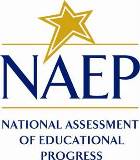
February 2022
revised July 2022
This Appendix F2 (formerly Appendix I4) was used in the 2022 Long-Term Trend Age 13 administration and reflected the MyNAEP system screens used by schools to communicate with and transmit information to NAEP. A newer version of MyNAEP, now known as the Assessment Management System (AMS), is replacing this older MyNAEP system across all NAEP assessments. NAEP is currently updating the AMS in preparation for 2025 LTT. As such, the new AMS screens are not yet available for this Clearance Package. The screens and text in this Appendix F2 will be adapted for 2025 LTT Amendment #2 and will be available for review in Appendix F in Summer 2024. See also Appendix F1 for more on the forthcoming Appendix F.
Table of Contents
Student Attendance (- Provide School Information Questions) 8
NAEP Representative Protocols (Provide School Information Questions) 10
Review and Verify List of Students Selected for NAEP 13
Review and Verify Student Information 15
Complete SD/EL Student Information 23
Review NAEP Inclusion Policy 24
Give Access to SD and/or EL Specialists 26
Provide Information for Students Who Are Both SD and EL 27
Provide Information for SD (IEP or 504 Plan) Only 32
Create Accommodation Sessions (Field Staff Only) 50
Provide NAEP Team Instructions 58
Download Parent/Guardian Notification Template 66
Verify Parent/Guardian Notification 67
Identify Questionnaire Respondents 70
Send Welcome Emails and Questionnaires 71
Monitor Questionnaire Completion and Send Reminder Emails 72
Select Strategies to Encourage Participation 79
Support Assessment Activities 81
Instructions for the School Coordinator brochure 83
Review and Verify List of Students Selected for NAEP 87
Information Needed to Review and Verify List of Students Selected for NAEP 87
Dept. of Agriculture Memo Authorizing Release of NSLP to NAEP 90
Complete SD/EL Student Information 91
Inclusion on NAEP Fact Sheet 91
Letter from Department of Education Encouraging Inclusion 96
Information Needed to Include SD/EL Students 98
Parent’s page on Nation’s Report Card website 100
What Every Parent Should Know About NAEP: PDF version 100
What Every Parent Should Know About NAEP: Video version 100
Manage Questionnaires Welcome Email 101
Manage Questionnaires – NAEP School Questionnaire - Link 101
Manage Questionnaires – NAEP School Questionnaire - Password 102
Manage Questionnaires Reminder Email 103
Manage Questionnaires Reminder Password 104
Support Assessment Activities 105
Description of MyNAEP: The school coordinators are responsible for preparing for the Long-term trend (LTT) assessment in their school using the MyNAEP system, which is an online secure site that provides participating schools with a convenient way to prepare for the upcoming assessment. MyNAEP serves as the primary resource and action center throughout the assessment process. The site also offers school coordinators an electronic way to prepare for the assessment at their own pace. The NAEP field representative will schedule an initial call to pre-review the major areas of the MyNAEP system with the school coordinator. A description of the tasks completed in the MyNAEP system can be found in Part B. The content of the MyNAEP system is included in this appendix.
Notes on the organization of Appendix I3
Red text indicates descriptive notes and references to Appendices other than I4.
Green text indicates text from hyperlinks or references within this document.
The Additional Resources section of this document (beginning on page 83) contains the text of hyperlinks.
MyNAEP Login Screen
Welcome
MyNAEP is a restricted-use website that contains information on the National Assessment of Educational Progress (NAEP), widely known as The Nation's Report Card.
Login
Email or Username:
Password:
Forgot Username or Password
Having trouble logging in?
First time visiting the 2022 MyNAEP site?
Paperwork Reduction Act (PRA) Statement
National Center for Education Statistics (NCES) conducts the National Assessment of Educational Progress to evaluate federally supported education programs. All of the information you provide may be used only for statistical purposes and may not be disclosed, or used, in identifiable form for any other purpose except as required by law (20 U.S.C. §9573 and 6 U.S.C. §151). By law, every NCES employee as well as every NCES agent, such as contractors and NAEP coordinators, has taken an oath and is subject to a jail term of up to 5 years, a fine of $250,000, or both if he or she willfully discloses ANY identifiable information about you. Electronic submission of your information will be monitored for viruses, malware, and other threats by Federal employees and contractors in accordance with the Cybersecurity Enhancement Act of 2015.
NCES estimates the time required to complete this information collection to average 270 minutes for schools that do not submit student sample information or 390 minutes for schools that submit student sample information manually, plus an additional 10 minutes for each student identified as SD or EL, including the time to review instructions, search existing data resources, gather the data needed, and complete and review the information collection. This voluntary information collection was reviewed and approved by OMB (Control No. 1850-0928). If you have any comments concerning the accuracy of the time estimate, suggestions for improving this collection, or any comments or concerns regarding the status of your individual submission, please write to: National Assessment of Educational Progress (NAEP), National Center for Education Statistics (NCES), Potomac Center Plaza, 550 12th St., SW, 4th floor, Washington, DC 20202, or send an email to: nces.information.collections@ed.gov.
When you have finished or if you need to stop before finishing, please LOG OUT of the survey system by clicking "Save and exit" and CLOSE ALL browser windows or screens to keep your responses secure. For example, if you used Chrome or Safari to open the survey, make sure no Chrome or Safari windows or screens are open after you end the survey. Not closing all browsers may allow someone else to see your responses.
OMB No. 1850-0928 APPROVAL EXPIRES 5/31/2024
Screenshot
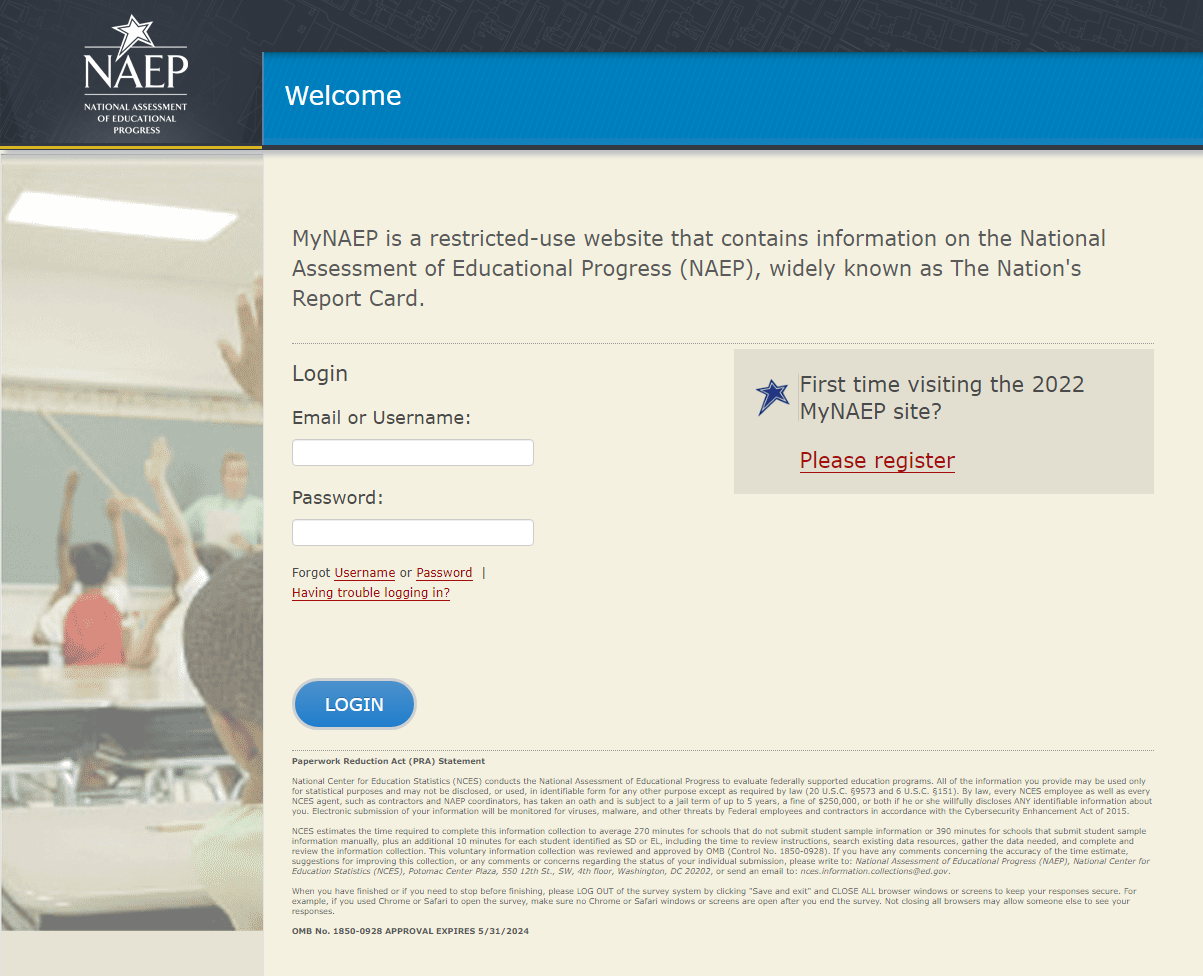
Home Page
Welcome to the National Assessment of Educational Progress!
The MyNAEP website will help you prepare for the assessment.
Assessment Details
Age:
Subject(s):
Assessment Date:
Preassessment Review Call Date:
NAEP Representative:
MyNAEP Registration ID:
NAEP School Coordinator:
*If a school coordinator name does not appear above, then no one is currently assigned as school coordinator. Notify your NAEP State Coordinator, ___(name)___, at ___(email address)___ if this information is missing. School coordinators must register their own MyNAEP account.
Prepare for Assessment
It's time to prepare for your school's upcoming assessment date.
The first step is to watch this quick tutorial video (https://bcove.video/2rHlh6v), which will give you an overview of the Prepare for Assessment menu.
Complete the activities in the menu before your scheduled preassessment review call.
What's Next?
Download teacher notification letters and student appointment cards in the Support Assessment Activities section.
Summary of Changes from OMB #1850-0928 v. 25:
Change Age 9 to Age 13
Screenshot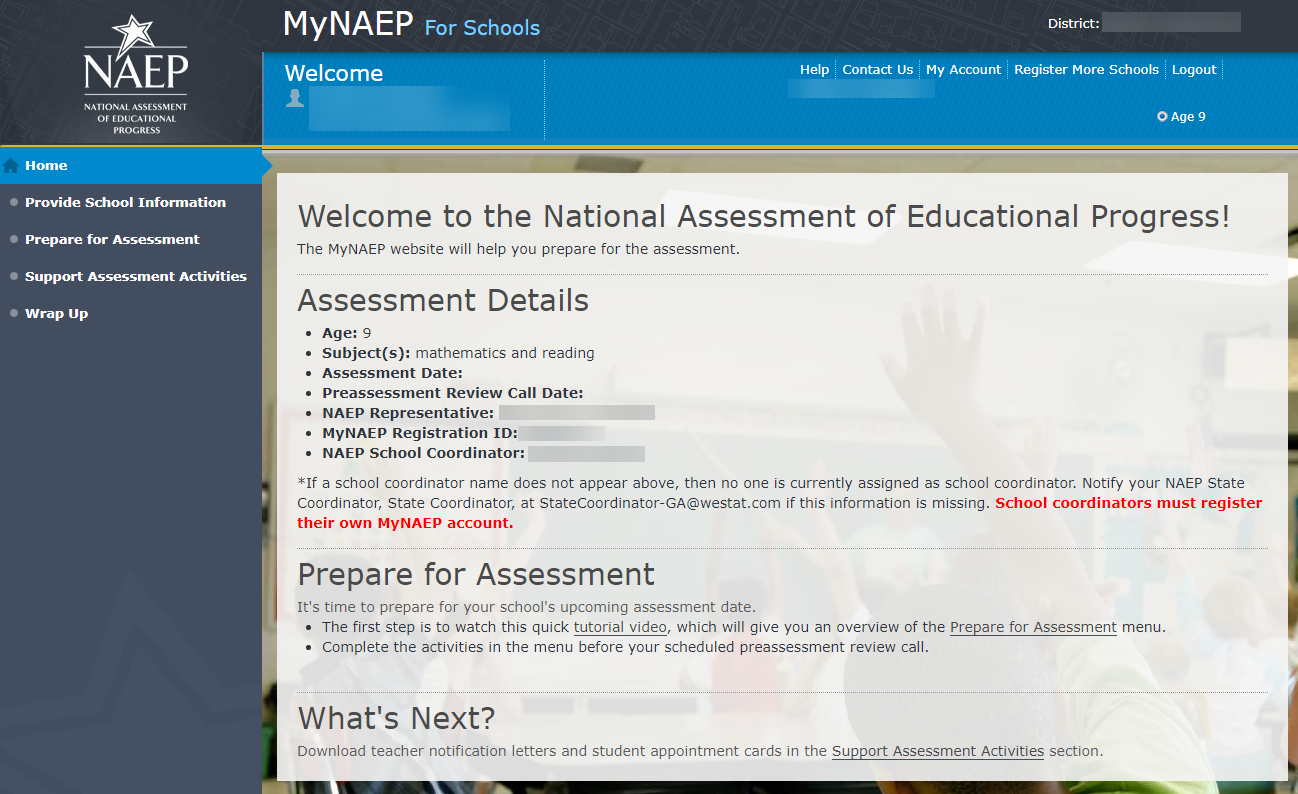
Provide School Information
Provide School Information
Please use the links below to ensure that NAEP has the most up-to-date information about your school.
Complete the following:
School Contact Information
School name and address
Shipping address
Principal contact information
School coordinator contact information
School Characteristics Information
Student enrollment
Charter school status
Date school adjourns for winter break in December
Date school returns from winter break in January
School calendar type (traditional or year round)
School start and end times
Student Attendance and NAEP Representative Protocols
Student Attendance
NAEP Representative Protocols
Summary of Changes from OMB #1850-0928 v. 25:
Change Age 9 to Age 13
Screenshot

Student Attendance (- Provide School Information Questions)
Student Attendance
NAEP assessments are administered to a sample of students on a single day. Each student takes an assessment in one subject area: mathematics or reading. The assessment takes approximately 90 minutes of student time to complete.
Please answer the following questions so NAEP can conduct the assessments in your schools.
Refer to the following definitions to answer the questions.
In Person: Your school building is open, and learning is conducted through face-to-face instruction at least one day a week.
Full time remote/virtual: Students attending school at home, using computers and/or at-home packets to learn remotely. Students do not attend any classes on campus.
Currently: As of today what is your enrollment. You only need to enter this once and you do not need to update as enrollment changes.
1. Select all days during which age 13 students attend school in your school building.
Monday
Tuesday
Wednesday
Thursday
Friday
2. Your age 13 enrollment is XX. <Note: if this number is missing, the following text will appear instead, “Your age 13 enrollment is missing from the School Characteristics section.”>.
List the number of age 13 students in each category below. The number of students in the three categories below should total to your total enrollment in the textbox above.
Full-time remote/virtual – receives instruction remotely and does not come to the school building

Full-time in person – receives instruction in-person at the school building

Part-time in person – receives instruction part-time in person at the school building

Summary of Changes from OMB #1850-0928 v. 25:
Change age 9 to Age 13
These are new questions, to clarify how/when 13-year-old students are attending school.
Screenshot

NAEP Representative Protocols (Provide School Information Questions)
NAEP Representative Protocols
NAEP representatives provide significant support to your school by administering the assessment and bringing all necessary materials and equipment. NAEP representatives’ top priority is to protect the health and safety of students and school staff.
Please answer the following questions so the NAEP representatives are prepared to administer assessments to the students in your school.
1. NAEP representatives follow the protocols in the COVID-19 Protocols fact sheet. Do NAEP representatives need to follow additional protocols when administering assessments to students in your school?
Yes
No
2. Do any state or district policies require NAEP representatives to be vaccinated for COVID-19 to administer assessments to students in your school?
Yes
No
3. Do any state or district policies require NAEP representatives to test negative for COVID-19 prior to administering assessments to students in your school?
Yes
No
Summary of Changes from OMB #1850-0928 v. 25:
Change Age 9 to Age 13
Screenshot

Prepare for Assessment
Prepare for Assessment
Use the links on the left-hand menu under Prepare for Assessment to:
Review and verify the list of students selected for NAEP
Complete information about how students with disabilities and English learners will participate in NAEP
Plan assessment day logistics
Notify parents/guardians of sampled students
Manage the school questionnaire
Encourage participation and motivate students to do their best
Your NAEP representative will schedule a phone call with the school coordinator and review the completed preassessment activities.
Additional Resources
Instructions for the School Coordinator (see Additional Resources section of this document)
Summary of Changes from OMB #1850-0928 v. 25
Change Age 9 to Age 13
Screenshot
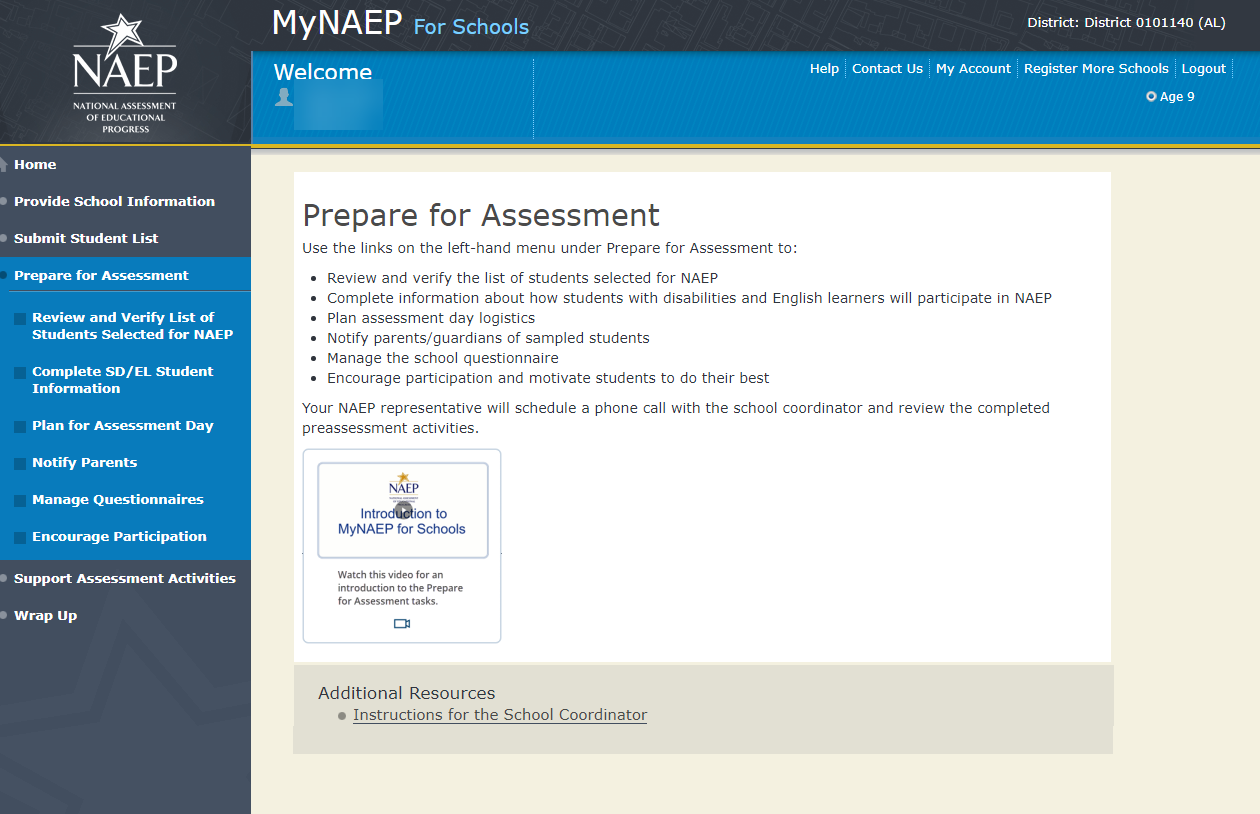
Review and Verify List of Students Selected for NAEP
Note: The student list is initially submitted outside of the MyNAEP system and the information is loaded into MyNAEP for the school coordinator to review and verify for accuracy.
Prepare for Assessment
Review and Verify List of Students Selected for NAEP
NAEP reports results for student demographic groups, so it is important to collect accurate data. Review the list of students to be tested at your school and update their enrollment status and demographic information as needed.
Complete the following:
Watch the Review and Verify List of Students Selected for NAEP Tutorial (5:03) (https://bcove.video/2fEo6iA)
Review and Verify Student Information
Print Reports
Additional Resources
Information Needed to Review and Verify List of Students Selected for NAEP
(see Additional Resources section of this document)
Dept. of Agriculture Memo Authorizing Release of NSLP to NAEP
(see Additional Resources section of this document)
Summary of Changes from OMB #1850-0928 v. 25
Change Age 9 to Age 13
Screenshot

Review and Verify Student Information
Review and Verify Student Information
Print Worksheet – REV-INFO-1
Select Print Worksheet to review and note changes to student enrollment status and demographics on a hardcopy worksheet. Select Continue when you are ready to enter information into MyNAEP.
Some students may not be eligible to participate in NAEP. A list of possible reasons is available here.
(Note: the content of the list is provided below for convenience of reviewing this appendix)
Reasons Student Cannot Take NAEP:
Withdrawn
Graduated
Expelled
Attends all classes on a different campus
Traditional homeschool learner - parent provides curriculum and may/may not act as instructor
Student listed more than once
Not in tested age group
Foreign exchange student
Student deceased
Long-term illness/homebound
Parent notified about NAEP and refused NAEP testing
Student notified about NAEP and refused NAEP testing
Enrolled in U.S. schools less than one full academic year before the NAEP assessment and cannot access NAEP (applies only to English learners)
Meets (or met) participation criteria for one or more state alternative assessments (applies only to students with disabilities)
Full-time virtual learner
Summary of Changes from OMB #1850-0928 v. 25
Change Age 9 to Age 13
Screenshot
 Review
and Verify Student Information
Review
and Verify Student Information
Demographic Data-REV-INFO-2
Note: School coordinators will be asked to review and verify student demographic information (as shown in the screenshot below), and also to indicate whether students were displaced from a natural disaster (screen REV-INFO-6).
Review all demographic data for the students listed below.
Select the Edit pencil next to the student name to enter a student's correct or missing information, indicate a reason the student cannot take NAEP, and update their in-person or virtual learning status. It is important for NAEP to know if students are attending school in-person, or are part-time or full-time virtual/remote learners.
Icons in the column header indicate missing data. Hover over the
 icon to see how many students have missing data.
icon to see how many students have missing data.
All columns can be sorted by clicking on the column header. Missing data will filter to the top.
Update students with a Section 504 Plan that require an accommodation in the Student with Disability column to Yes, 504.
Indicate students who are part-time virtual learners in the "Is this student a virtual learner" column.
Summary of Changes from OMB #1850-0928 v. 25:
Change Age 9 to Age 13
Screenshot

Review and Verify Student Information-REV-INFO-6
Identify Displaced Students
Due to natural disasters, families may be forced from their homes, displacing students who have enrolled outside their home district or state. For reporting purposes, NAEP is collecting information about displaced students.
Are any of the students listed below enrolled in your school because they were displaced from another district or state by a disaster, such as a hurricane?
Summary of Changes from OMB #1850-0928 v. 25
Change Age 9 to Age 13
Screenshot

Review and Verify Student Information
Print Summary Report-REV-INFO-7
Select Print Summary to print a record of the student information entered into MyNAEP. Keep this report in a secure location and refer to it during the preasessment review call.
Select Submit when you are finished with this section.
Please certify that you have reviewed all the demographic data, have updated any students to 504 that need accommodations, and updated any students who are not able to participate on NAEP by typing your name in the box.
Summary of Changes from OMB #1850-0928 v. 25
Change Age 9 to Age 13
Screenshot
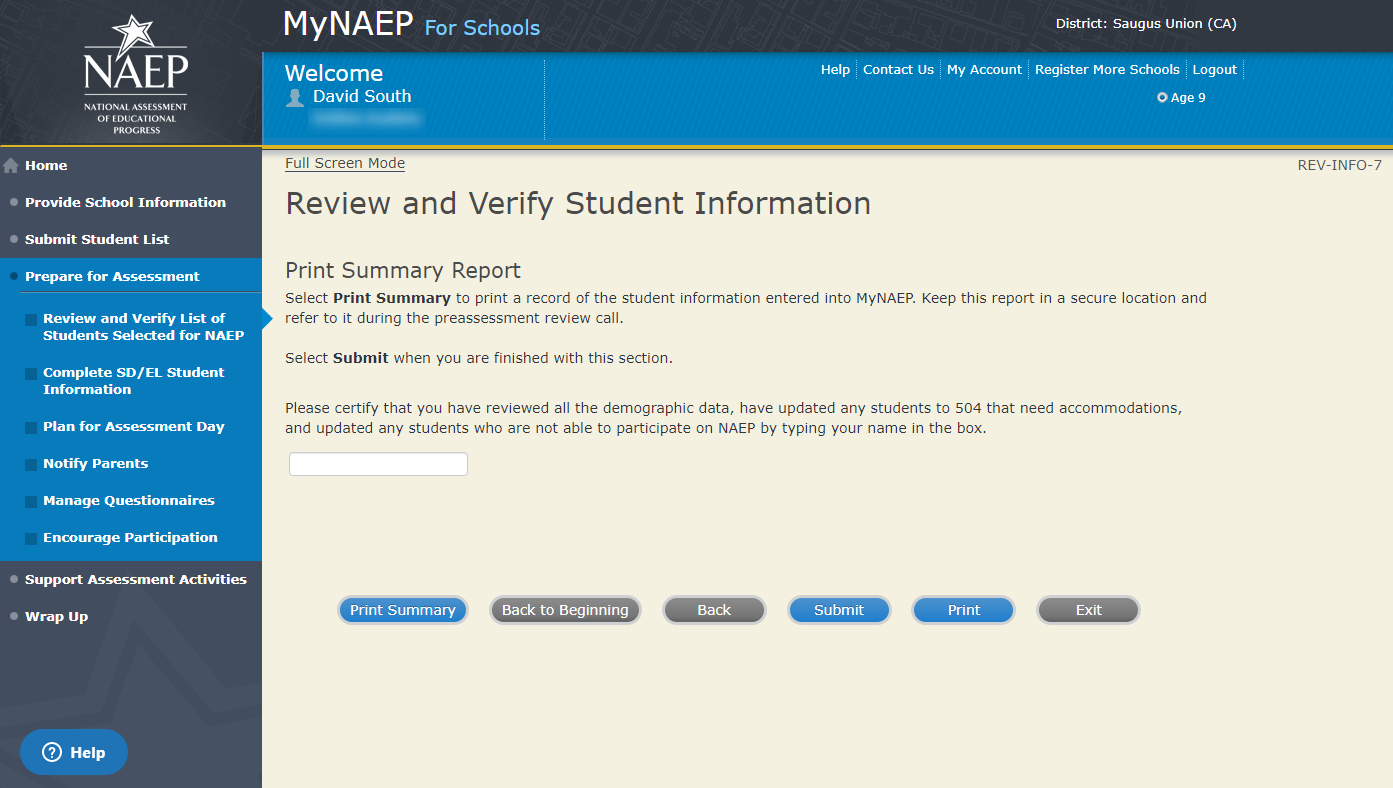
Print Reports
Print Reports – REV-REP-1
Before entering student data in the system
Print this worksheet and use it to review and verify student enrollment status and demographics before entering the data into the system.
After entering student data in the system
Select Print Summary Report to print a record of the student information entered in the system. Keep this report in a secure location and refer to it during the preassessment review call.
Select Submit to indicate you are finished with this section.
Summary of Changes from OMB #1850-0928 v. 25
Change Age 9 to Age 13
Screenshot

 Sample
of information included in the worksheet and summary report
(note the worksheet is a resource to
assist school coordinator in collecting the information that will be
contained in the summary report)
Sample
of information included in the worksheet and summary report
(note the worksheet is a resource to
assist school coordinator in collecting the information that will be
contained in the summary report)
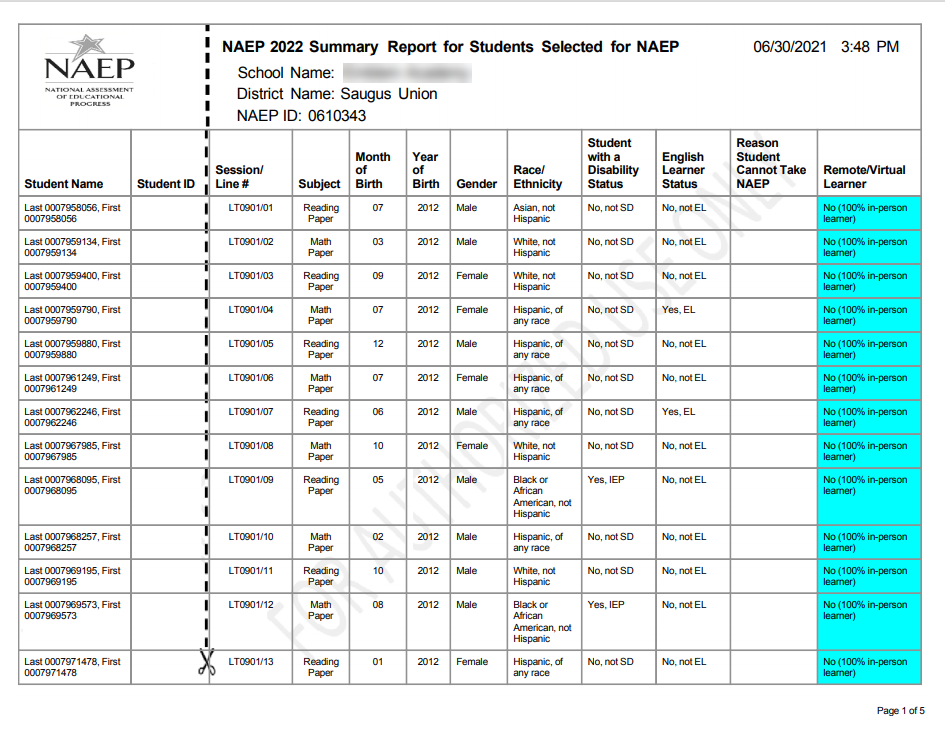
Complete SD/EL Student Information
Note: In this section the school coordinator will provide information to determine how students participate in NAEP (i.e., without accommodations, with accommodations, or do not test). The school coordinator will provide the Individuals with Disabilities Education Act (IDEA) disability status, English proficiency, primary language, grade-level performance, and accommodations, using the state-specific NAEP inclusion policies (see Appendices D3-16 and D3-17 for templates of the SD and EL inclusion policies, which are customized by the NAEP State Coordinators). The purpose of providing this information is to make sure students have appropriate supports to access the NAEP assessment.
Prepare for Assessment
Complete SD/EL Student Information
To ensure that NAEP reflects the educational progress of all students, students with disabilities (SD) and English learners (EL) must be included to the fullest extent possible.
NAEP provides accommodations only for SD and EL. Therefore, this section only includes students whose SD status is "Yes, IEP" or "Yes, 504" or EL status is "Yes, EL." Changes to these status codes can only be made in the Review and Verify List of Students Selected for NAEP section.
The information that you provide in this section indicates how students will participate in NAEP and the accommodations they will receive.
Complete the following:
Watch Complete SD/EL Student Information Tutorial (5:59) (https://bcove.video/2fECUxM)
Review NAEP Inclusion Policy
Give Access to SD and/or EL Specialist(s) (optional)
Provide Information for Students Who Are Both SD and EL
Provide Information for SD (IEP or 504 Plan) Only
Provide Information for EL Only
Print Reports
Create Accommodation Sessions (Field Staff Only)
Additional Resources
Inclusion on NAEP Fact Sheet
Letter from Department of Education Encouraging Inclusion
Information Needed to Include SD/EL Students
Summary of Changes from OMB #1850-0928 v. 25
Change Age 9 to Age 13
Screenshot

Review NAEP Inclusion Policy
Review NAEP Inclusion Policy-COMP-INCL 1-1
[State Name] NAEP 2022 Inclusion Policy for Students with Disabilities and English learners
The policy provides inclusion expectations, lists the NAEP accommodations, and describes how the accommodations are administered.
[State Name] SD Inclusion Policy (See Appendix D1-5)
[State Name] EL Inclusion Policy (See Appendix D1-6)
We expect most students with disabilities and English learners to participate. The only students eligible for exclusion are:
Students who meet (or met) participation criteria for the [Alternate Assessment 1] and [Alternate Assessment 2].
English learners who have been enrolled in U.S. schools less than 1 full academic year before the NAEP assessment and cannot access NAEP.
All other SD and EL students should participate with or without NAEP accommodations.
Monitoring Exclusions
Your NAEP State Coordinator will monitor exclusions and may contact you regarding excluded students. If you have any questions about how to include a student, contact your NAEP State Coordinator, [State Coordinator name], at [State Coordinator name].
I downloaded and reviewed the Alabama NAEP 2022 Inclusion Policy for Students with Disabilities and English Learners.
Yes No
Select the Submit button to record your response above.
Summary of Changes from OMB #1850-0928 v. 25
Change Age 9 to Age 13
Screenshot
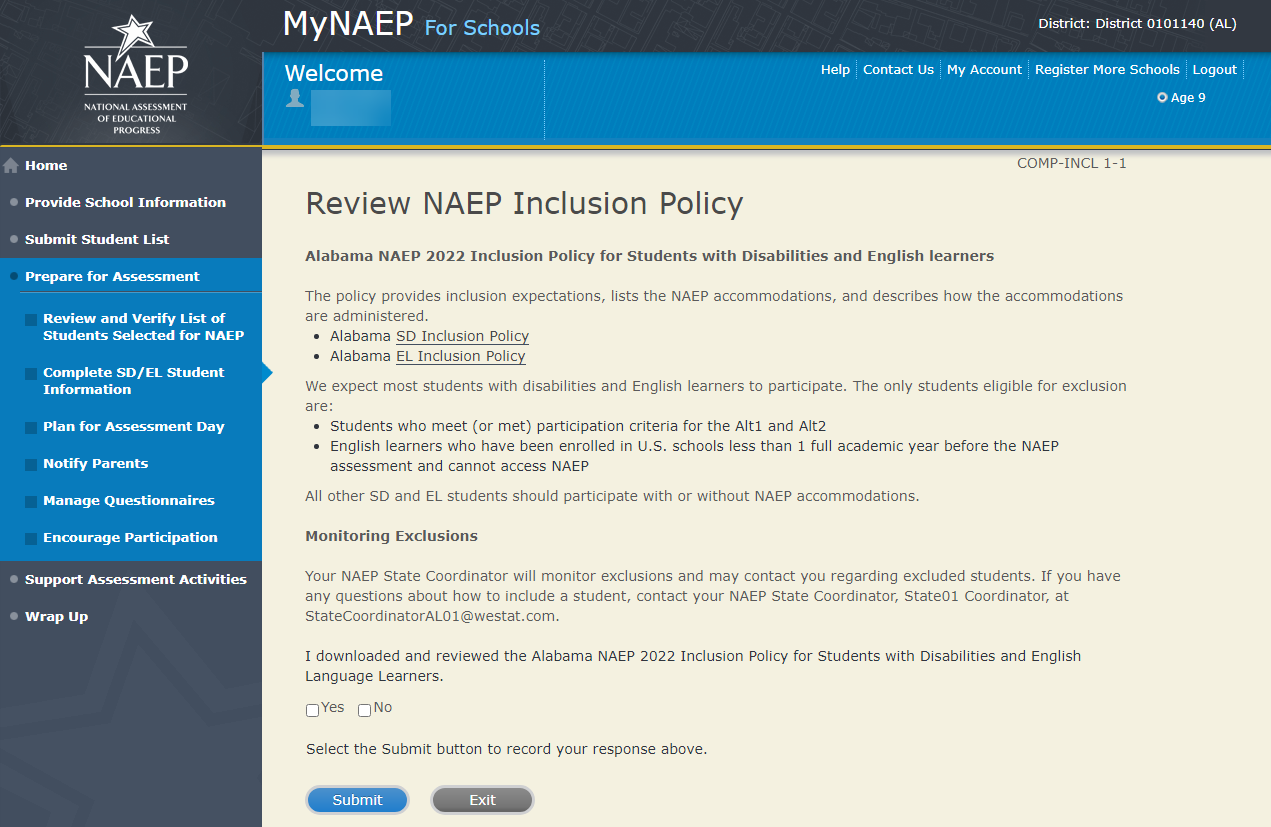
Give Access to SD and/or EL Specialists
Please complete the Review and Verify List of Students Selected for NAEP section before giving access to SD and/or EL Specialists
Give Access to SD and/or EL Specialists-COMP-SPEC 1-1
The person most familiar with how students with disabilities (SD) and English learners (EL) are tested should provide the information for these students. Complete and submit the information below to give access to the Complete SD/EL Student Information section for one or more SD/EL specialists.
For confidentiality reasons, access is limited to you and five additional school staff.
Enter all names and email addresses then select Save.
Select the Send Email button for each record.
Select Submit.
Summary of Changes from OMB #1850-0928 v. 25
Change Age 9 to Age 13
Screenshot

Provide Information for Students Who Are Both SD and EL
Print Worksheet-COMP-BOTH-2
Select Print Worksheet to record the information for each student on a hardcopy worksheet. Select Continue when you're ready to enter information into MyNAEP.
Review the NAEP inclusion policy (see Appendices D3-16 and D3-17) to see the universal design elements and accommodations for NAEP, and to determine how students should participate.
Summary of Changes from OMB #1850-0928 v. 25:
Change Age 9 to Age 13
Screenshot
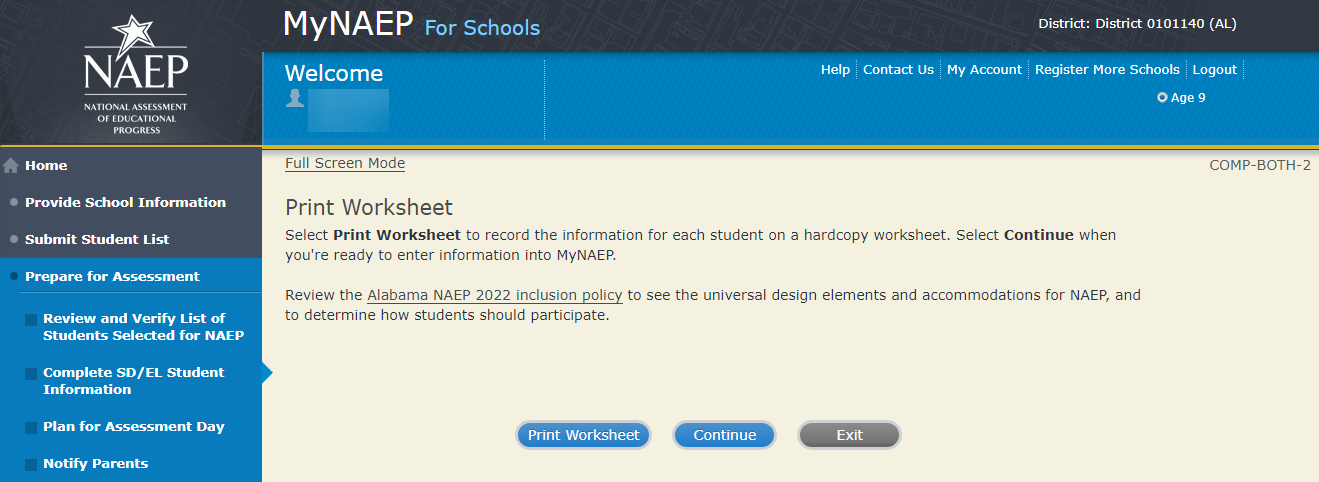
EL Details-COMP-BOTH-3
For each student listed below, record the following information by selecting the Edit pencil next to the student name. Review the NAEP inclusion policy (see Appendices D3-16 and D3-17) prior to completing.
What is the student's primary language?
Including this year, how long has this student been receiving academic instruction primarily in English? (note a hover note displays in the system that reads: Instructor presents academic content in English and the student receives only occasional translation of words or explanation of ideas/concepts in his/her native language.)
At what grade level (note a hover note displays in the system that reads: For example, a grade 4 student is selected to take the NAEP math assessment who performs at a second-grade level should be marked as two or more years below grade level.) does this student perform in the NAEP subject?
How would you characterize this student’s English proficiency (note a hover note displays in the system that reads: How this student's English language proficiency compares to other ELs in the same grade.) in listening comprehension, reading, speaking, and writing?
All columns can be sorted by selecting the column header.
Summary of Changes from OMB #1850-0928 v. 25:
Change Age 9 to Age 13
Screenshot
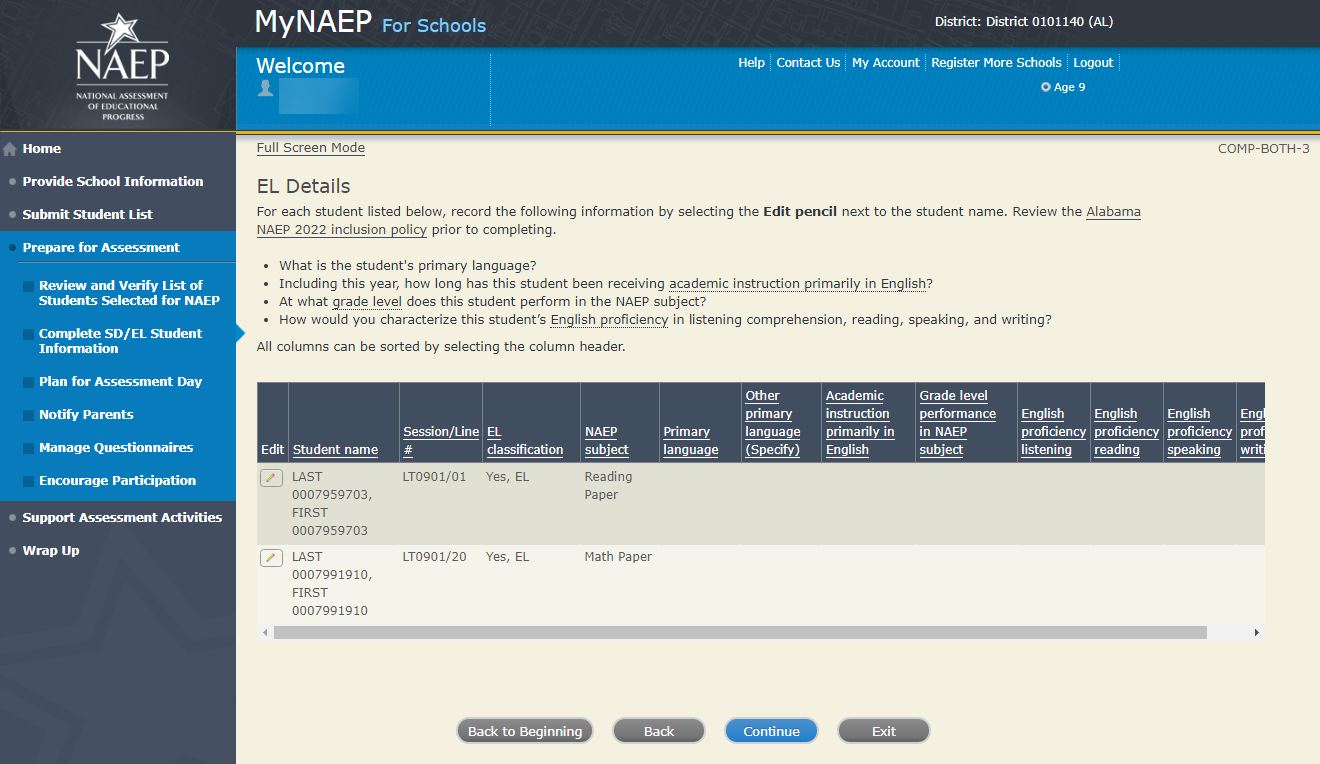
SD Details-COMP-BOTH-4
For each student listed below, record the following information by selecting the Edit pencil next to the student name. Review the NAEP inclusion policy prior to completing.
Which of the following IDEA categories (see list below) best describes each student’s identified disability(ies)? (Note: This question is not applicable to students marked as Yes, 504.)
Autism
Deaf-blindness
Developmental delay
Emotional disturbance
Hearing impairment, including deafness
Intellectual disability
Multiple disabilities
Orthopedic impairment
Other health impairment
Specific learning disability
Speech or language impairment
Traumatic brain injury
Visual impairment, including blindness
What is the degree (note that in the system a hover note appears that reads: The response should be based on the knowledge of the person most familiar with this student's disability(ies) and based on the professional judgment how it/they might compare to other students with similar) of each student's disability(ies)?
All columns can be sorted by selecting the column header.
Summary of Changes from OMB #1850-0928 v. 25:
Change Age 9 to Age 13
Screenshot

How Students Should Participate-COMP-BOTH-5
For each student listed below, record the following information by selecting the Edit pencil next to the student name. Review the {State} NAEP inclusion policy (see Appendices D3-16 and D3-17) prior to completing. If you have any questions on how to include students, contact your NAEP State Coordinator, First and Last Name, at Email address.
How long has each student been enrolled in U.S. schools?
How is each student assessed on the state or classroom assessments in the NAEP subject?
How should each student be assessed on NAEP?
(If appropriate) What accommodations does the student need to access NAEP?
(If appropriate) Reason student cannot take NAEP?
(If appropriate) Is the decision to exclude each student a school decision or a parent/student decision?
All columns can be sorted by selecting the column header.
Summary of Changes from OMB #1850-0928 v. 25:
Change Age 9 to Age 13
Screenshot

Exclusions Summary-COMP-BOTH-7
The student(s) listed below are marked as “Do not test” and will be excluded from the NAEP assessment.
Your NAEP State Coordinator will monitor exclusions and may contact you regarding excluded students. If you have any further questions on how to include students, contact your NAEP State Coordinator, First and Last Name, at Email address and/or review the {State} NAEP inclusion policy (see Appendices D3-16 and D3-17).
Select Back to make any changes for the students on the previous screen.
All columns can be sorted by selecting the column header.
Summary of Changes from OMB #1850-0928 v. 25:
Change Age 9 to Age 13
Screenshot

Print Summary Report-COMP-BOTH-8
Thank you for providing student data. If you have any further questions, contact your NAEP State Coordinator, First and Last Name, at Email address.
Your NAEP State Coordinator will monitor exclusions and may contact you regarding excluded students.
Select Print Summary to print a record of the student information entered into MyNAEP. Keep this report in a secure location and refer to it during the preassessment review call.
Select Submit when you are finished with this section.
Summary of Changes from OMB #1850-0928 v. 25:
Change Age 9 to Age 13
Screenshot
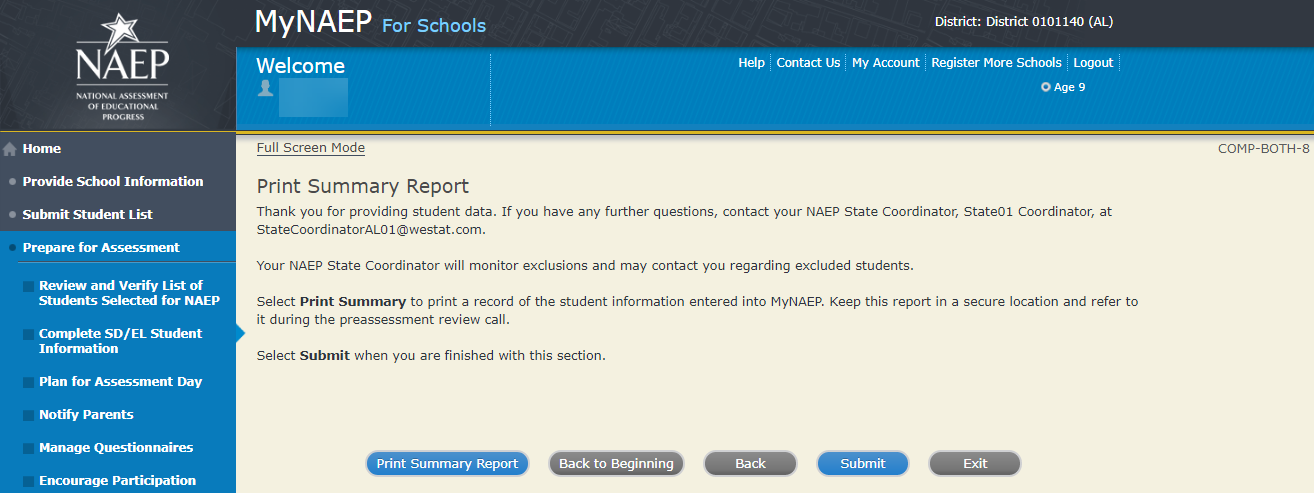
Provide Information for SD (IEP or 504 Plan) Only
Print Worksheet-COMP-SD-2
Select Print Worksheet to record the information for each student on a hardcopy worksheet. Select Continue when you're ready to enter information into MyNAEP.
Review the NAEP inclusion policy (see appendix D1-5) to see the universal design elements and accommodations for NAEP, and to determine how students should participate.
Summary of Changes from OMB #1850-0928 v. 25:
Change Age 9 to Age 13
Screenshot
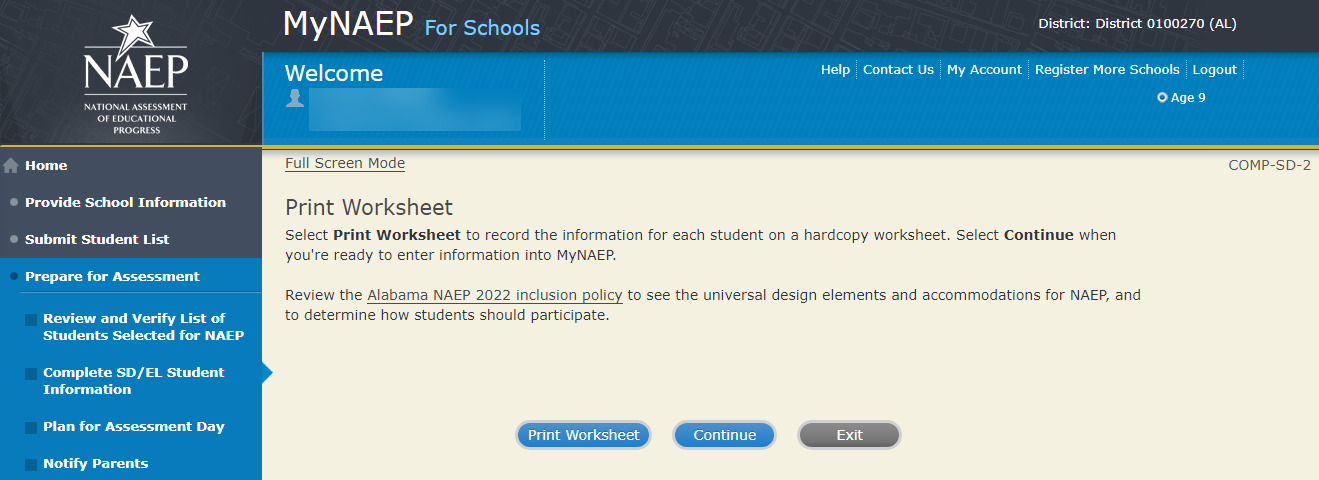
SD Details-COMP-SD-3
For each student listed below, record the following information by selecting the Edit pencil next to the student name:
Which of the following IDEA categories (see list below) best describes each student’s identified disability(ies)? (Note: This question is not applicable to students marked as Yes, 504.)
Autism
Deaf-blindness
Developmental delay
Emotional disturbance
Hearing impairment, including deafness
Intellectual disability
Multiple disabilities
Orthopedic impairment
Other health impairment
Specific learning disability
Speech or language impairment
Traumatic brain injury
Visual impairment, including blindness
What is the degree (note that in the system a hover note appears that reads: The response should be based on the knowledge of the person most familiar with this student's disability(ies) and based on the professional judgment how it/they might compare to other students with similar) of each student's disability(ies)?
At what grade level (note that in the system a hover note appears that reads: For example, a grade 4 student is selected to take the NAEP math assessment who performs at a second-grade level should be marked as two or more years below grade level) does this student perform in the NAEP subject?
All columns can be sorted by selecting the column header.
Summary of Changes from OMB #1850-0928 v. 25:
Change Age 9 to Age 13
Screenshot
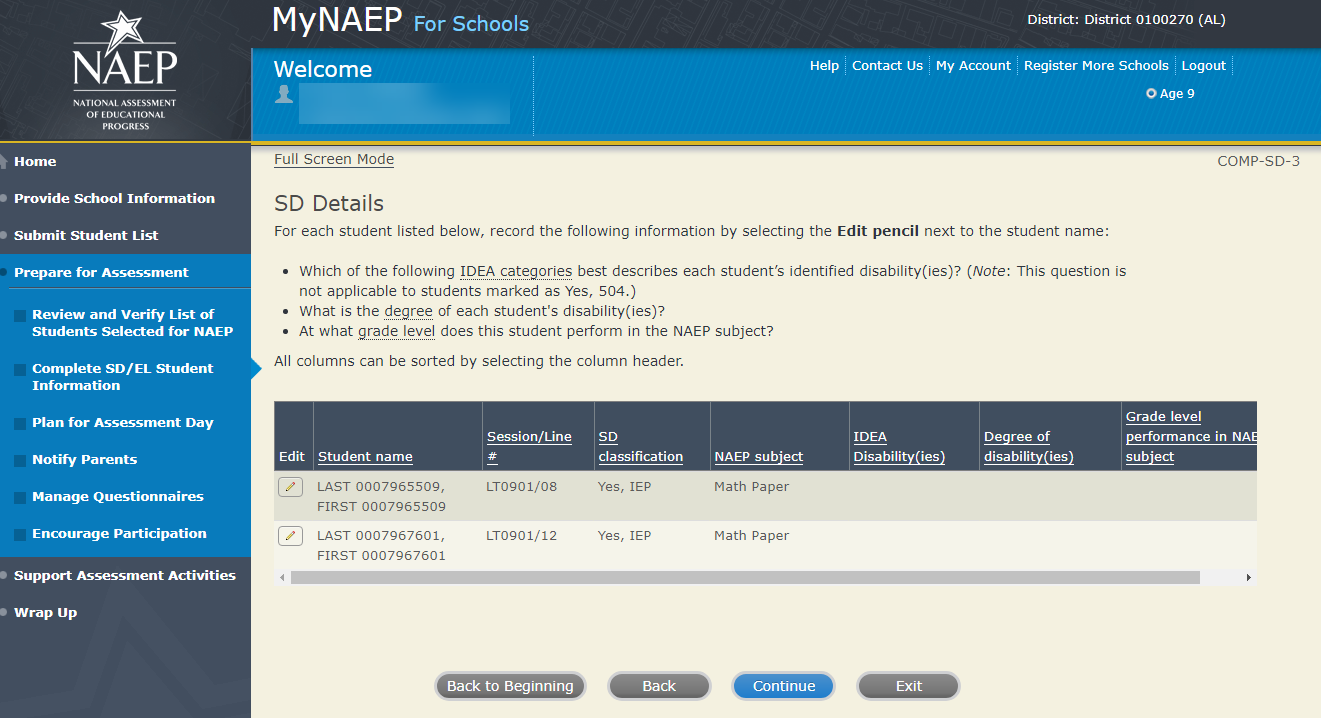
How Students Should Participate-COMP-SD-4
For each student listed below, record the following information by selecting the Edit pencil next to the student name. Review the {State} NAEP inclusion policy (see appendix D1-5) prior to completing. If you have any questions on how to include students, contact your NAEP State Coordinator, First and Last Name, at Email address.
How is each student assessed on the state or classroom assessments in the NAEP subject?
How should each student be assessed on NAEP?
(If appropriate) What accommodations does the student need to access NAEP?
(If appropriate) Reason student cannot take NAEP?
(If appropriate) Is the decision to exclude each student a school decision or a parent/student decision?
All columns can be sorted by selecting the column header.
Summary of Changes from OMB #1850-0928 v. 25:
Change Age 9 to Age 13
Screenshot
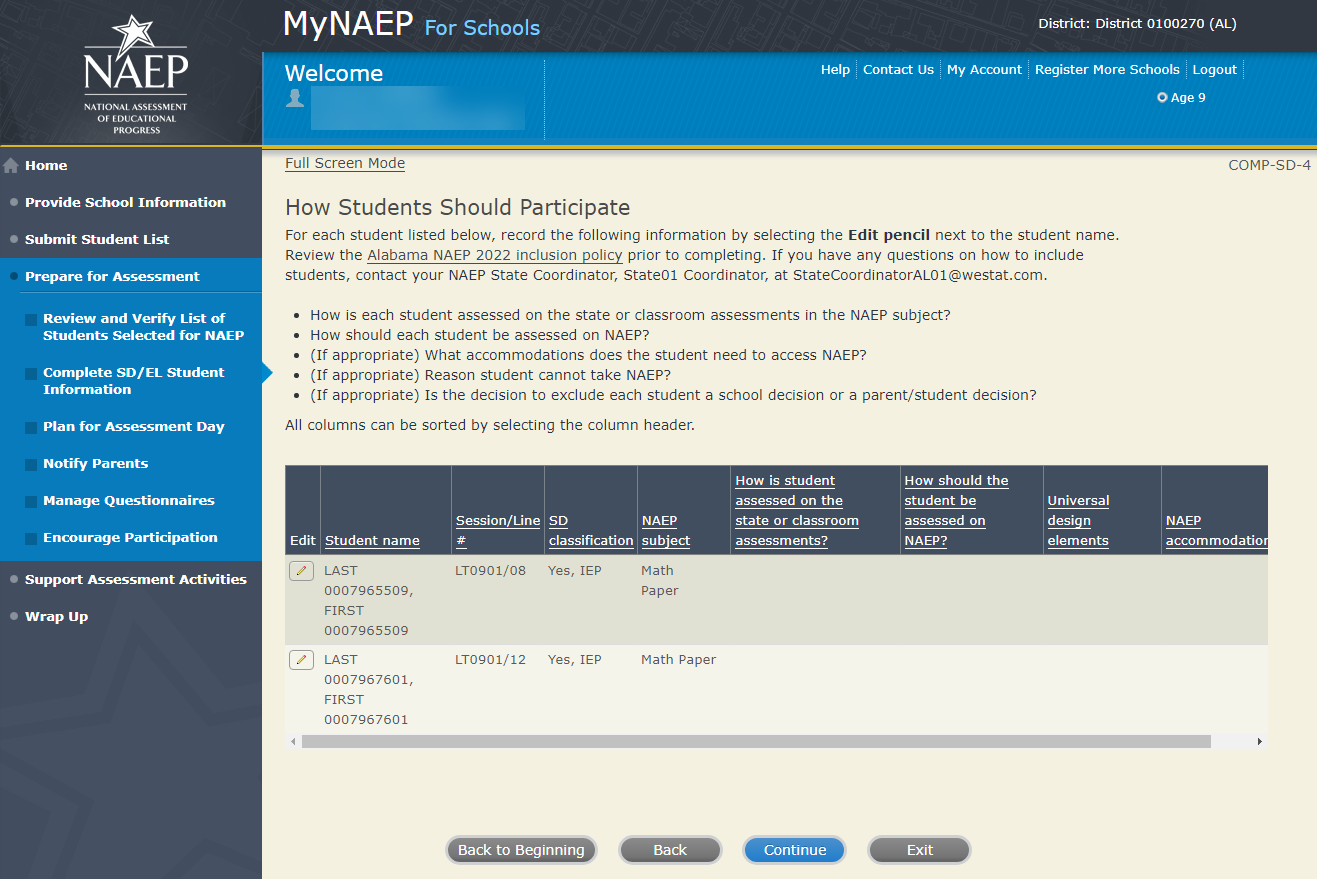
Exclusions Summary-COMP-SD-6
The student(s) listed below are marked as “Do not test” and will be excluded from the NAEP assessment.
Your NAEP State Coordinator will monitor exclusions and may contact you regarding excluded students. If you have any further questions on how to include students, contact your NAEP State Coordinator, First and Last Name, at Email address and/or review the {State} NAEP inclusion policy (see appendix D1-5).
Select Back to make any changes for the students on the previous screen.
All columns can be sorted by selecting the column header.
Summary of Changes from OMB #1850-0928 v. 25:
Change Age 9 to Age 13
Screenshot

Print Summary Report-COMP-SD-7
Thank you for providing student data. If you have any further questions, contact your NAEP State Coordinator, First and Last Name, at Email address.
Your NAEP State Coordinator will monitor exclusions and may contact you regarding excluded students.
Select Print Summary to print a record of the student information entered into MyNAEP. Keep this report in a secure location and refer to it during the preassessment review call.
Select Submit when you are finished with this section.
Summary of Changes from OMB #1850-0928 v. 25:
Change Age 9 to Age 13
Screenshot

Provide Information for EL Only
Print Worksheet-COMP-EL-2
Select Print Worksheet to record the information for each student on a hardcopy worksheet. Select Continue when you're ready to enter information into MyNAEP.
Review the NAEP inclusion policy (see appendix D1-6) to see the universal design elements and accommodations for NAEP, and to determine how students should participate.
Summary of Changes from OMB #1850-0928 v. 25:
Change Age 9 to Age 13
Screenshot

EL Details-COMP-EL-3
For each student listed below, record the following information by selecting the Edit pencil next to the student name. Review the NAEP inclusion policy (see appendix D1-6) prior to completing.
What is the student's primary language?
Including this year, how long has this student been receiving academic instruction primarily in English? (note a hover note displays in the system that reads: Instructor presents academic content in English and the student receives only occasional translation of words or explanation of ideas/concepts in his/her native language.)
At what grade level (note a hover note displays in the system that reads: For example, a grade 4 student is selected to take the NAEP math assessment who performs at a second-grade level should be marked as two or more years below grade level) does this student perform in the NAEP subject?
How would you characterize this student’s English proficiency (note a hover note displays in the system that reads: How this student's English language proficiency compares to other ELS in the same grade.) in listening comprehension, reading, speaking, and writing?
All columns can be sorted by selecting the column header.
Summary of Changes from OMB #1850-0928 v. 25:
Change Age 9 to Age 13
Screenshot
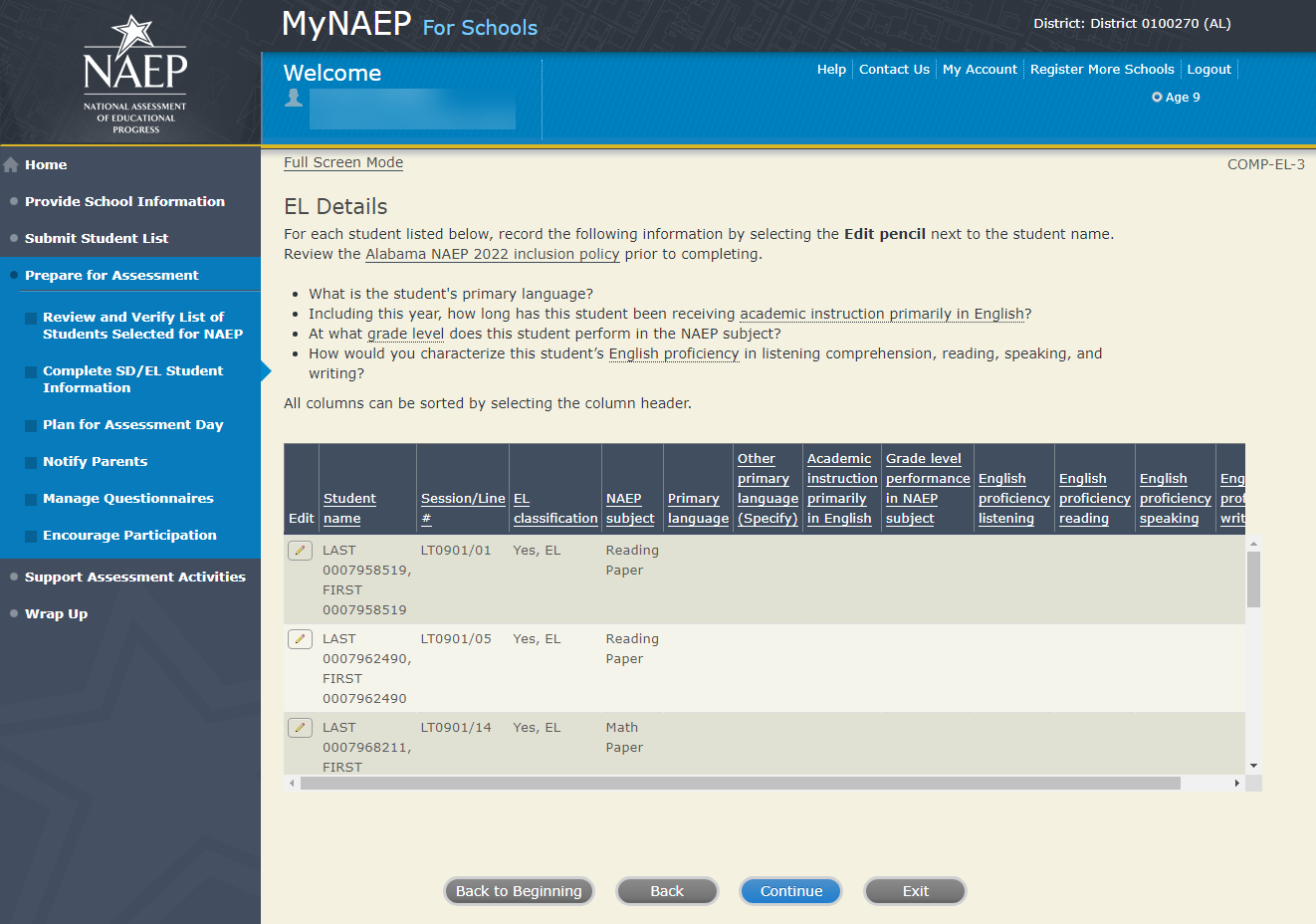
How Students Should Participate-COMP-EL-4
For each student listed below, record the following information by selecting the Edit pencil next to the student name. Review the {State} NAEP inclusion policy (see appendix D1-6) prior to completing. If you have any questions on how to include students, contact your NAEP State Coordinator, First and Last Name, at Email address.
How long has each student been enrolled in U.S. schools? (One full academic year is defined as one full school year before the assessment)
How should the student be assessed on NAEP?
(If appropriate) What universal design elements and accommodations does the student need to access NAEP?
(If appropriate) Reason student cannot take NAEP?
(If appropriate) Is the decision to exclude each student a school decision or a parent/student decision?
All columns can be sorted by selecting the column header.
Summary of Changes from OMB #1850-0928 v. 25:
Change Age 9 to Age 13
Screenshot

Exclusions Summary-COMP-EL-5
The student(s) listed below are marked as “Do not test” and will be excluded from the NAEP assessment.
Your NAEP State Coordinator will monitor exclusions and may contact you regarding excluded students. If you have any further questions on how to include students, contact your NAEP State Coordinator, First and Last Name, at Email address and/or review the {State} NAEP 2022 inclusion policy (see appendix D1-6).
Select Back to make any changes for the students on the previous screen.
All columns can be sorted by selecting the column header.
Summary of Changes from OMB #1850-0928 v. 25:
Change Age 9 to Age 13
Screenshot
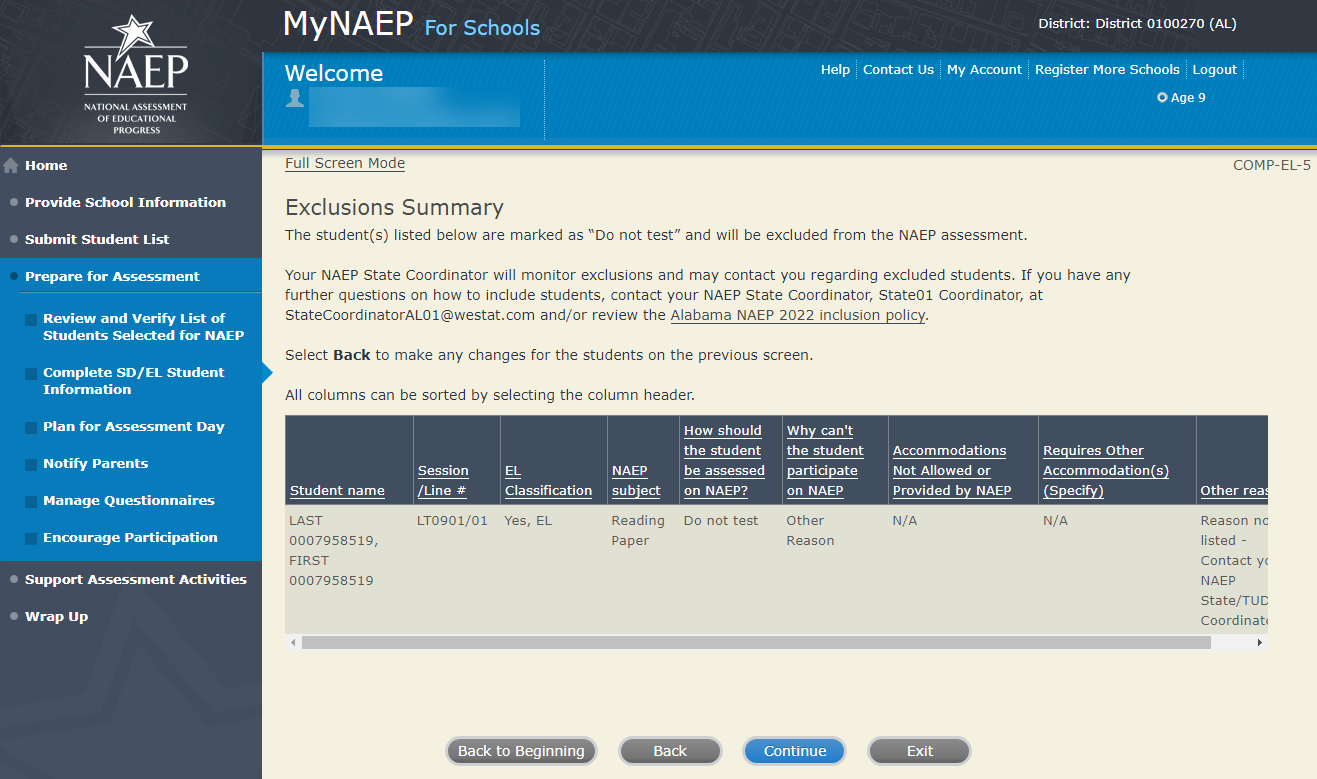
Print Summary Report-COMP-EL-6
Thank you for providing student data. If you have any further questions, contact your NAEP State Coordinator, First and Last Name, at Email address.
Your NAEP State Coordinator will monitor exclusions and may contact you regarding excluded students.
Select Print Summary to print a record of the student information entered into MyNAEP. Keep this report in a secure location and refer to it during the preassessment review call.
Select Submit when you are finished with this section.
Summary of Changes from OMB #1850-0928 v. 25:
Change Age 9 to Age 13
Screenshot
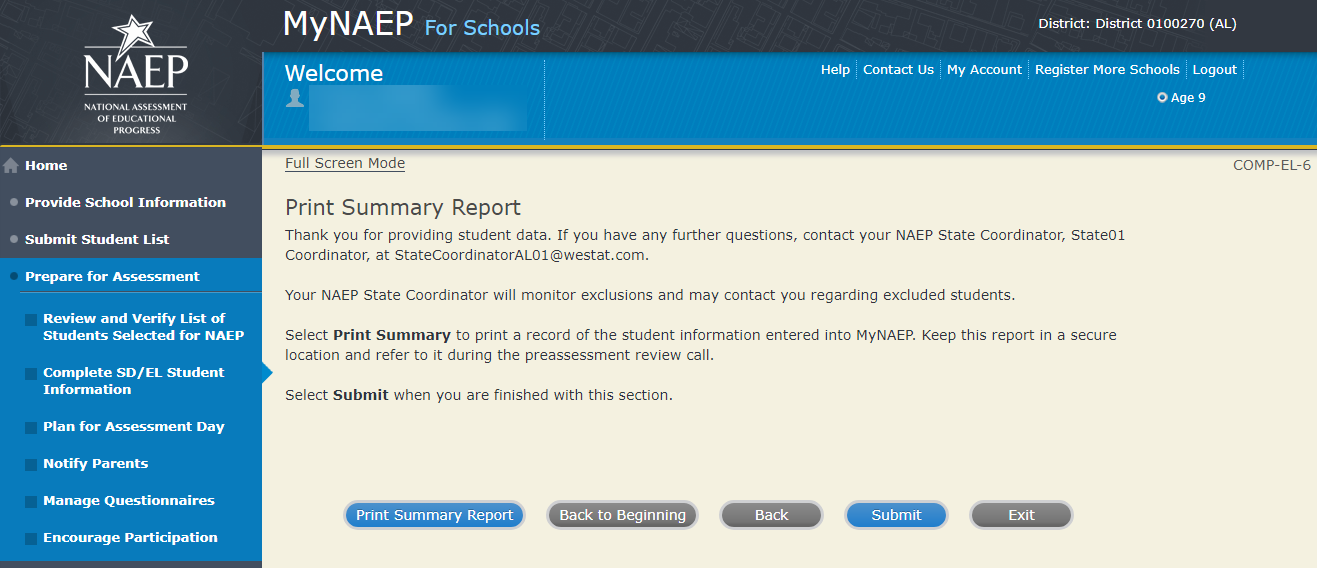
Print Reports
Print Reports-COMP-REP-1
Before entering student data in the system
Print the worksheets to record student information.
After entering student data in the system
Select Print Summary Report to print a record of the student information entered in the system. Keep this report in a secure location and refer to it during the preassessment review call. Print the Exclusion Report to discuss with the NAEP State Coordinator.
Summary of Changes from OMB #1850-0928 v. 25:
Change Age 9 to Age 13
Screenshot
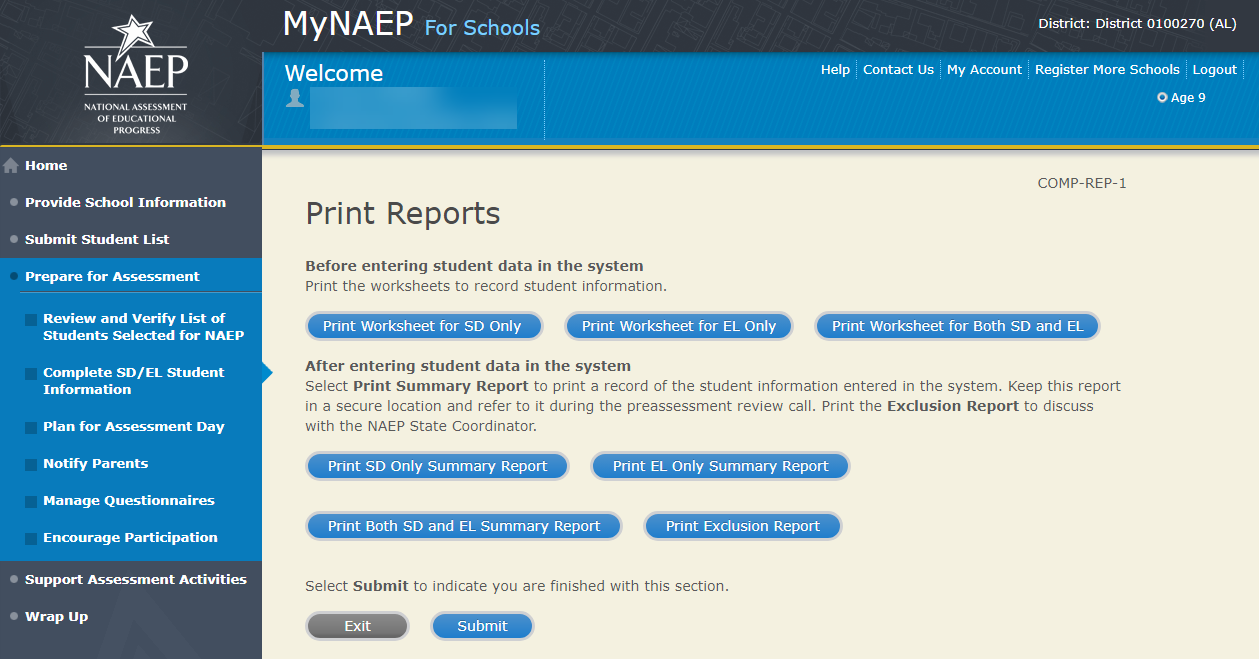
Sample of information contained in worksheets and reports:
(Note: the worksheets are resources to assist teachers in collecting the information that will be contained in the summary reports)
Both SD and EL
Worksheet Page 1
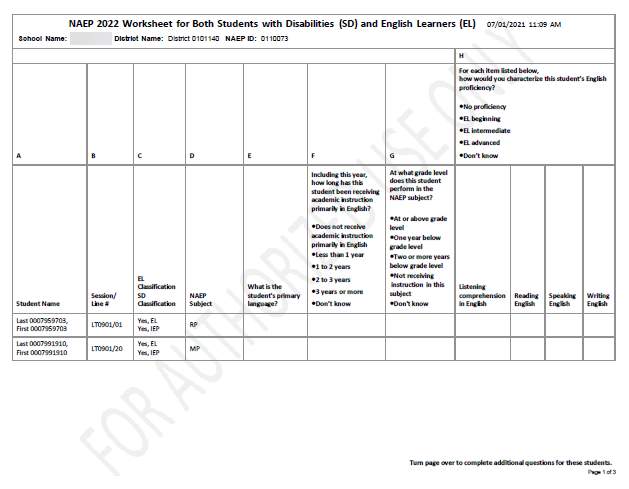
Worksheet Page 2

Worksheet Page 3
(Note: “Alt 1” and “Alt 2” will be replaced with the respective name of the state)

For SD Only
Worksheet Page 1
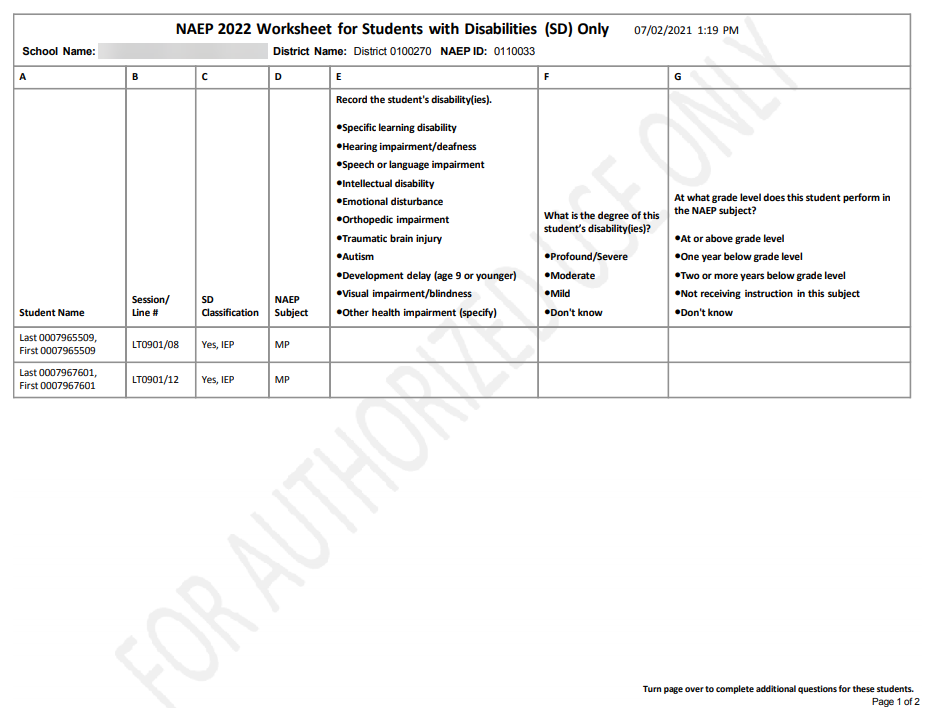
Worksheet Page 2
(Note: “New Moldavia” will be replaced with the respective name of the state)

For EL Only
Worksheet Page 1

Worksheet Page 2
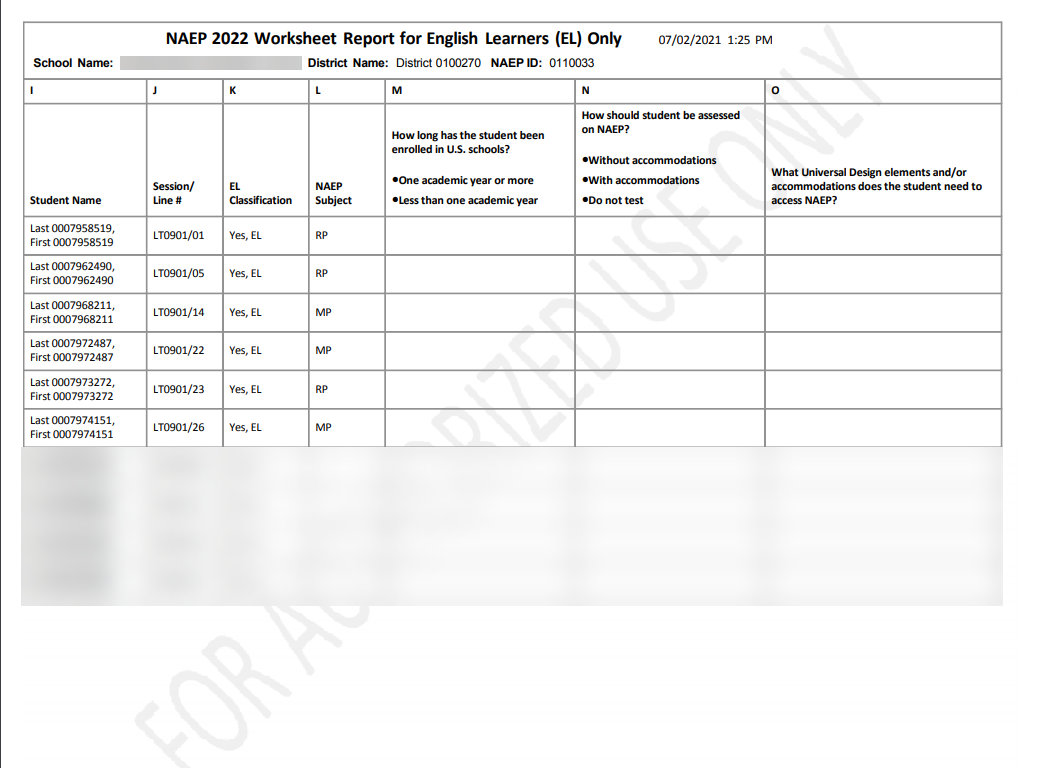
Create Accommodation Sessions (Field Staff Only)
COMP-ACCOM-1
The Submit button will be greyed out until you have green checkmarks for all the following links:
Provide Information for Students Who Are Both SD and EL
Provide Information for SD (IEP or 504 Plan) Only
Provide Information for EL Only
Once you select Submit, the system will create accommodation sessions based on the accommodations recorded for each student.
Do not select Submit until you have confirmed the SD/EL data for each student, as you can only complete this task once.
Summary of Changes from OMB #1850-0928 v. 25:
Change Age 9 to Age 13
Screenshot

Plan for Assessment Day
Note: In this section the school coordinator will determine assessment session times and locations, share cell phone policy to ensure security of NAEP items, and make a plan to encourage student participation. This is meant to ensure that the school is prepared for a successful administration of NAEP. There will be no digitally based assessments for long-term trend assessments.
Prepare for Assessment
Plan for Assessment Day
In this section, record assessment details and provide logistical instructions for the NAEP team to ensure that assessment day runs smoothly.
Note: If less than 90% of the selected students attend the assessment, the NAEP team may need to return to your school for a makeup assessment at a later date. Your NAEP representative will discuss this with you after the original assessment has been conducted.
Complete the following:
Watch Plan for Assessment Day Tutorial (3:53) (https://bcove.video/2fDAvDb)
Record Assessment Details
Provide NAEP Team Instructions
Summary of Changes from OMB #1850-0928 v. 25:
Change Age 9 to Age 13
Screenshot

Record Assessment Details
Record Assessment Details-PLN-DET-1
Print Worksheet
Select Print Worksheet to download and print a copy of students selected to take NAEP. Use the worksheet to take notes as you scheduled assessment times and locations. Select Continue when you are ready.
Summary of Changes from OMB #1850-0928 v. 25:
Change Age 9 to Age 13
Screenshot

Record Assessment Details PLN-DET-2
School Schedules
Use the report link below (same from the previous screen) to answer the following question.
Record Assessment Details Summary Report
Will all selected students (except full-time virtual students) attend school in person on {scheduled assessment date}?
Summary of Changes from OMB #1850-0928 v. 25:
Change Age 9 to Age 13
Screenshot

Record Assessment Details PLN-DET-3
Testing Locations and Time Requirements
You’re about to select assessment locations and start times for NAEP.
Review the information below, and indicate when age 13 students break for lunch. On the next couple of screens, you will schedule testing locations and start times for each session.
Testing Locations
Select locations that...
have enough seats and adequate space for all students
are free of distractions and interruptions
have a board available for the NAEP team to write information
have flat desks or tables
Time Requirements
Locations should be available 60 minutes before the start time so that the NAEP team can set up.
Sessions will last about 60 minutes.
Enter the time that age X students take their lunch break.
Start Time: End Time:
Start Time: End Time:
Start Time: End Time:
Start Time: End Time:
Start Time: End Time:
Summary of Changes from OMB #1850-0928 v. 25:
Change Age 9 to Age 13
Screenshot
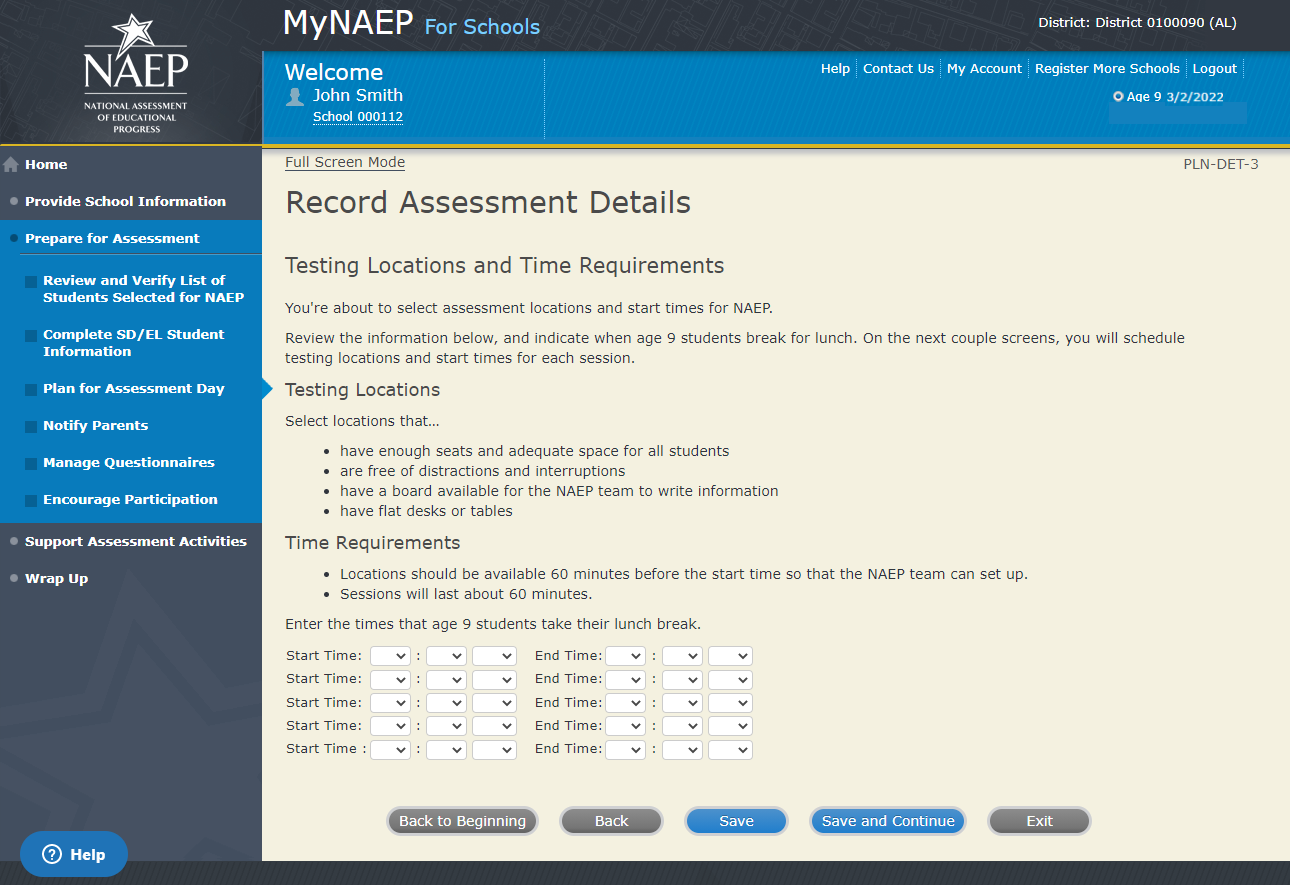
Record Assessment Details-PLN-DET-4
Students will take NAEP on paper.
Sessions can be tested together at the same time. Students can be divided into smaller groups to promote social distancing
Do you require students to be divided into smaller groups?
Yes
No
Note: XX students are expected to participate
Schedule Assessment Groups
Summary of Changes from OMB #1850-0928 v. 25:
Change Age 9 to Age 13
Screenshot

Record Assessment Details-PLN-DET-6
Tips
Students taking NAEP with extended time should be placed in the group that allows ample time for their accommodation.
Students who will not be taking NAEP and students who will be assessed in separate sessions do not appear on this page.
Assessment Groups
NAEP has assigned each student taking the assessment to a group.
If there is a scheduling conflict, you can use the group drop-downs to switch students below. Select Submit when you are finished.
<assessment date>
Group A, <location>: XX student(s)
Group B, <location>: XX student(s)
Total: XX
Summary of Changes from OMB #1850-0928 v. 25:
Change Age 9 to Age 13
Screenshot
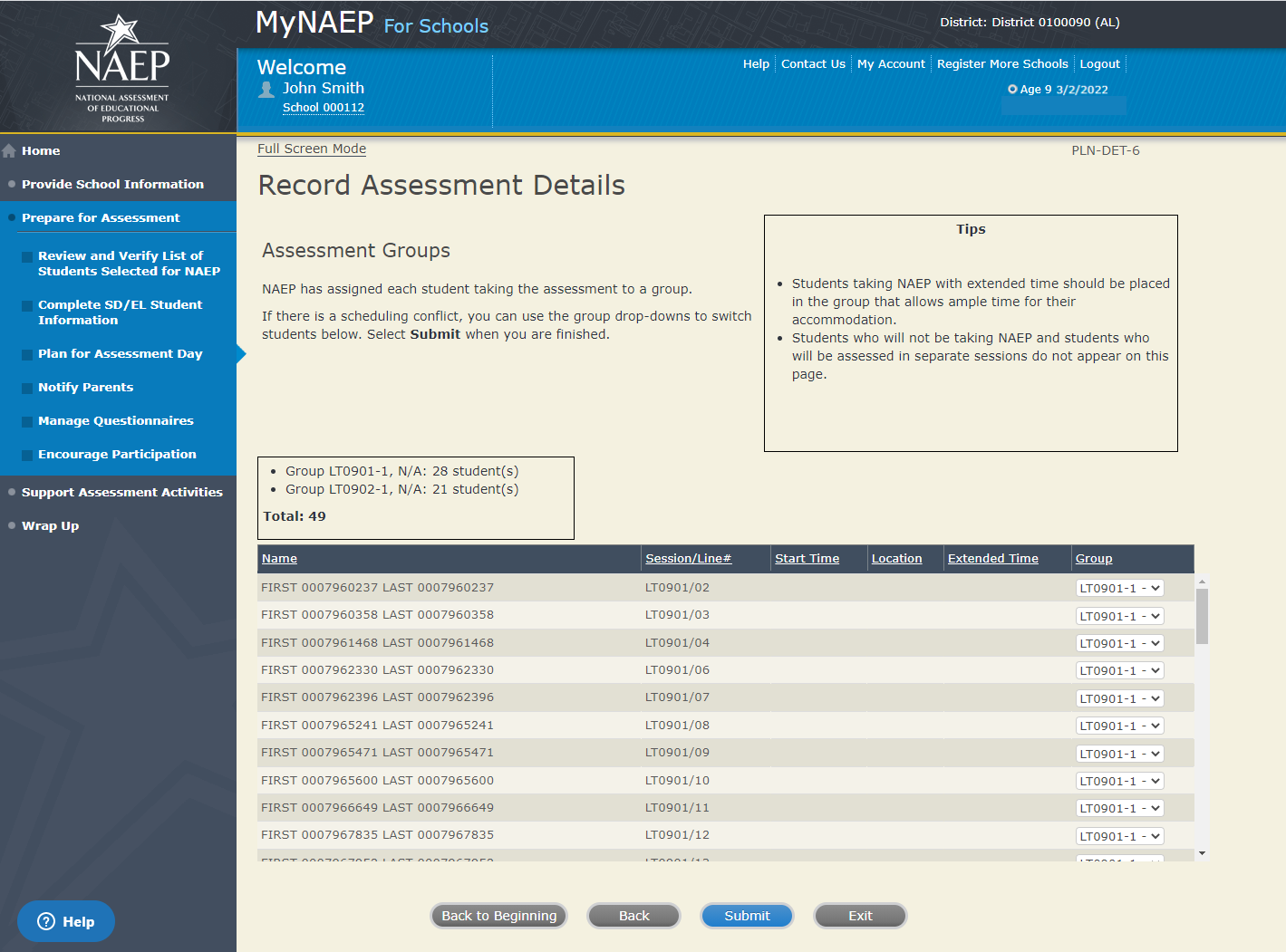
Record Assessment Details-PLN-DET-7
Combined Sessions
You’ve combined one or more sessions together.
To help the NAEP team conduct the assessment as smoothly as possible, please review these guidelines:
check the Number of Students column and make sure that your assessment location has enough seats
ask if a school staff member can help monitor room entrances during the assessment
provide a microphone for the NAEP team to use while giving instructions to the students
Summary of Changes from OMB #1850-0928 v. 25:
Change Age 9 to Age 13
Screenshot

Provide NAEP Team Instructions
Provide NAEP Team Instructions
COVID-19 Policies PLN-TEAM-1
As described in the NAEP COVID-19 Protocol document, field staff will use a variety of PPE and sanitizing tools, monitor their health, and follow strict testing and sanitizing protocols.
1. Besides the information outlined in the NAEP protocol document, are there any school specific COVID protocols that the field staff should follow?
2. NAEP representatives follow the protocols in the COVID-19 Protocols fact sheet. Do any state or district policies require NAEP representatives to be vaccinated for COVID-19 to administer assessments to students in your school?
Yes
No
If Yes to Q2, show additional question
2a. Which of the following statements best describes your school’s COVID-19 vaccination requirements for NAEP representatives. Please choose only one response.
NAEP representatives must be fully vaccinated against COVID-19 in order to enter our school, with no exceptions.
NAEP representatives must be fully vaccinated against COVID-19 in order to enter our school unless they have an exemption/accommodation for medical, religious, or other reasons protected by law and must otherwise adhere to the requirements described in the COVID-19 Protocols fact sheet.
NAEP representatives either must be fully vaccinated against COVID-19 in order to enter our school or must otherwise adhere to the requirements described in the COVID-19 Protocols fact sheet.
If the user selects b or c, show this follow up question
Please select one of the following statements regarding exempted unvaccinated NAEP representatives.
Unvaccinated NAEP representatives must show a recent negative COVID-19 test to enter our school.
Unvaccinated NAEP representatives do not need to show a recent negative COVID-19 test to enter our school.
3. Do any state or district policies require NAEP representatives to test negative for COVID-19 prior to administering assessments to students in your school?
Yes
No
4. How should the team handle visibly ill students?
5. Are school staff required to wear masks?
6. Are students required to wear masks?
7. Does the school require social distancing?
8. During the assessment, students often raise their hand to ask questions. What are your school’s protocols for answering student questions while following social distancing guidelines?
Summary of Changes from OMB #1850-0928 v. 25:
No changes
Screenshot
The screenshot below represents the change that will be made. At the time of this submission, the new screenshot was not available.

Provide NAEP Team Instructions
Before the Assessment-PLN-TEAM-2
1. Where should the team park?
2. The team will bring their NAEP ID badges and check in at the front office. Do they need to follow any other school protocols?
3. Before the assessment, your NAEP representative will need to briefly meet with you. Where will you be?
4. How and by what time does your school announce closings or delays?
5. The NAEP team wants to be sensitive to any special needs your students may have. Is there anything specific we need to know?
6. Students respond more positively when they know that the school administration supports NAEP. Can the principal or other school staff member take a moment during the daily announcements or before the assessment to introduce NAEP, reinforce its importance, and ask students to do their best?
Yes
No
7. NAEP provides appointment cards (available in the Support Assessment Activities section) to remind students of the assessment. Will you be printing and providing the students appointment cards?
I will be printing and distributing appointment cards to students
I will not be printing and distributing appointment cards to students
Summary of Changes from OMB #1850-0928 v. 25:
Change Age 9 to Age 13
Screenshot
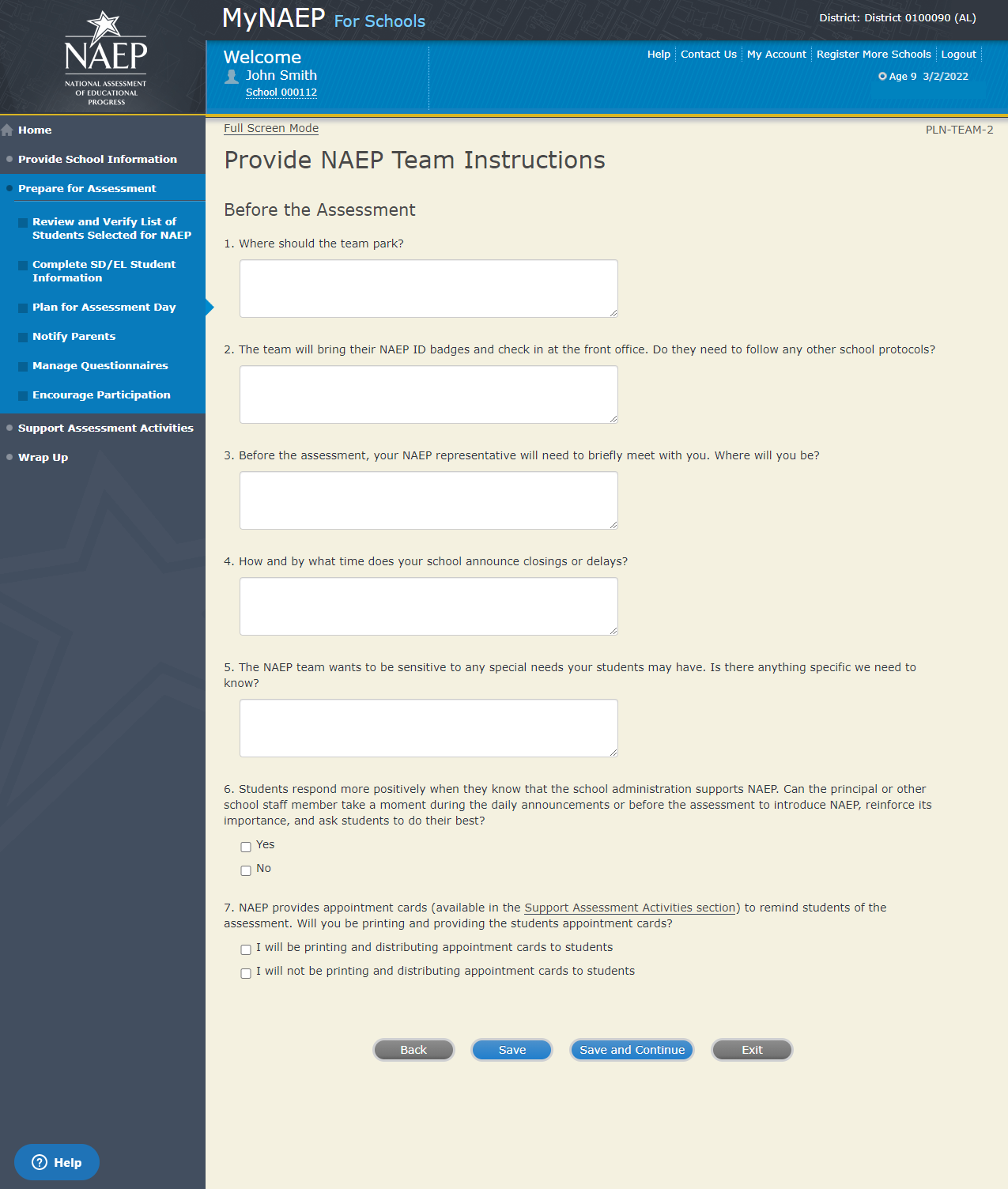
Provide NAEP Team Instructions
During the Assessment-PLN-TEAM-3
1. The law prohibits students from photographing or sharing NAEP questions. Please assist us with one of these security measures:
Notify students that cell phones are banned from the testing location
Notify students that cell phones must be turned off and placed with their belongings
No assistance can be provided
2. In case of an emergency, who should the NAEP team contact for assistance?
3. Is there anything scheduled, such as a fire drill or assembly, that might interrupt the assessment?
4. Are there any procedures or protocols that the NAEP team should follow in the event of an emergency situation such as a lock-down or an extreme weather event?
5. Once the students have begun reading the booklet directions, late students cannot be admitted. What instructions should the NAEP team give to students who arrive too late?
6. How should the NAEP team handle restroom breaks? Do students need hall passes?
7. Is it possible for a school staff member to remain in the room(s) during the assessment? NAEP field staff will administer the entirety of the assessment, however schools have reported that it is beneficial to have a school staff member in the room. The staff member serves a familiar person for the students, helps with disruptive behavior, and knows school procedures should for any situations that could arise.
Yes
No
Summary of Changes from OMB #1850-0928 v. 25:
Change Age 9 to Age 13
Screenshot

Provide NAEP Team Instructions
After the Assessment-PLN-TEAM-4
1. Students taking the paper assessment must be dismissed all together at the end of each session.
2. How should the NAEP team dismiss students who receive extended time, which may take up to three times as long?
3. Where should the NAEP team send students after the assessment?
4. After the assessment, your NAEP representative will need to briefly meet with you. Where will you be?
Summary of Changes from OMB #1850-0928 v. 25:
Change Age 9 to Age 13
Screenshot

Notify Parents
Note: In this section the school coordinator will download and customize the parent notification letter (see Appendix D4-8 [public schools] and D4-9 [private schools] for the template of the letter), upload the customized letter to the system, and certify the date parents were notified. This is to ensure that parents/legal guardians are notified of their student’s selection to participate in NAEP, which is a requirement of the Reauthorized Elementary and Secondary Education Act (ESEA).1
Prepare for Assessment
Notify Parents
All parents and guardians of selected students must be notified in writing before NAEP can conduct the assessment.
Complete the following:
Watch Notify Parents Tutorial (3:46) (https://bcove.video/2xyrOUA)
Download Parent/Guardian Notification Template
Upload Letter
Verify Parent/Guardian Notification
Additional Resources
Parent's page on Nation’s Report Card website
What Every Parent Should Know About NAEP: PDF version
What Every Parent Should Know About NAEP: Video version
Sample Questions Booklets
Summary of Changes from OMB #1850-0928 v. 25:
Change Age 9 to Age 13
Screenshot

Download Parent/Guardian Notification Template
Download Parent/Guardian Notification Template-PAR-TMP-1
You can download, customize, and distribute the parent notification letter(s) below.
Parent/Guardian Notification Letter (see Appendices D3-7 and D3-8)
Parent/Guardian Notification Letter (Spanish) (see Appendices D3-20 and D3-21)
Here are some suggestions for notifying parents about NAEP:
Mail/email the letter to parents
Send the letter home with students
Include the letter on the school website or in a newsletter
Unable to download the template? Try disabling pop-up blockers or adding mynaep.com as a trusted site to your browser. Still having trouble? Contact the NAEP help desk at 1-800-283-6237.
Summary of Changes from OMB #1850-0928 v. 25:
Change Age 9 to Age 13
Screenshot
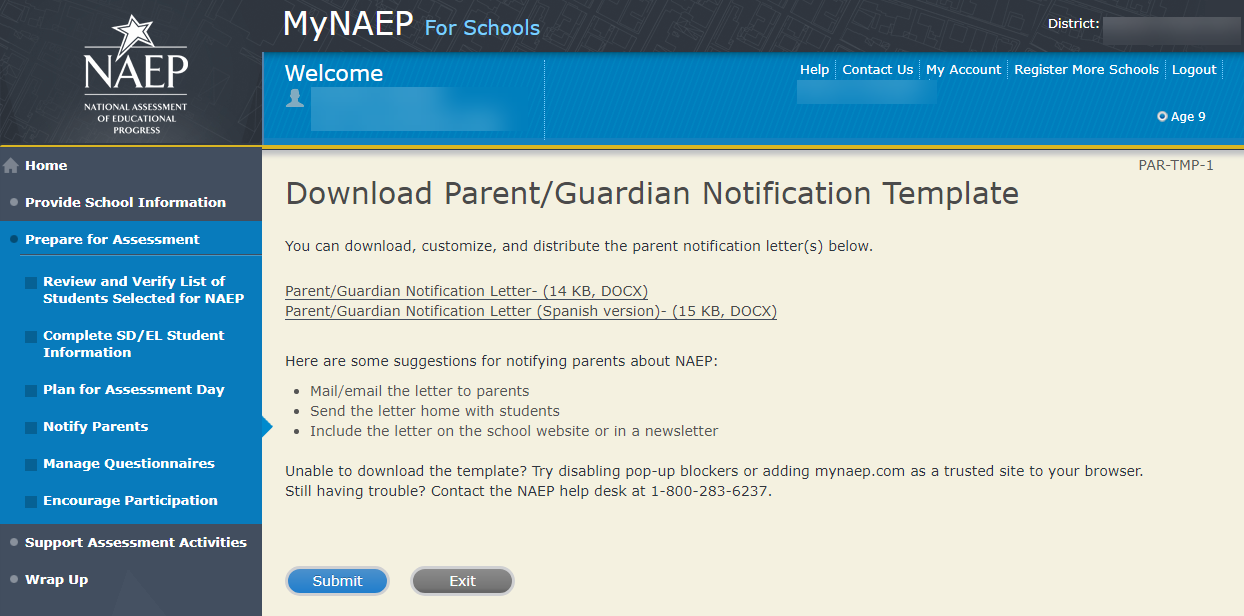
Upload Letter
Upload Letter-PAR-UPLD-1
1. When do you plan on distributing the letter?
2. Please upload the letter that you distributed to parents and guardians. If you distributed the letter in more than one language, just upload the English version.
Select Choose File or Browse... to locate and upload your file.
Summary of Changes from OMB #1850-0928 v. 25:
Change Age 9 to Age 13
Screenshot
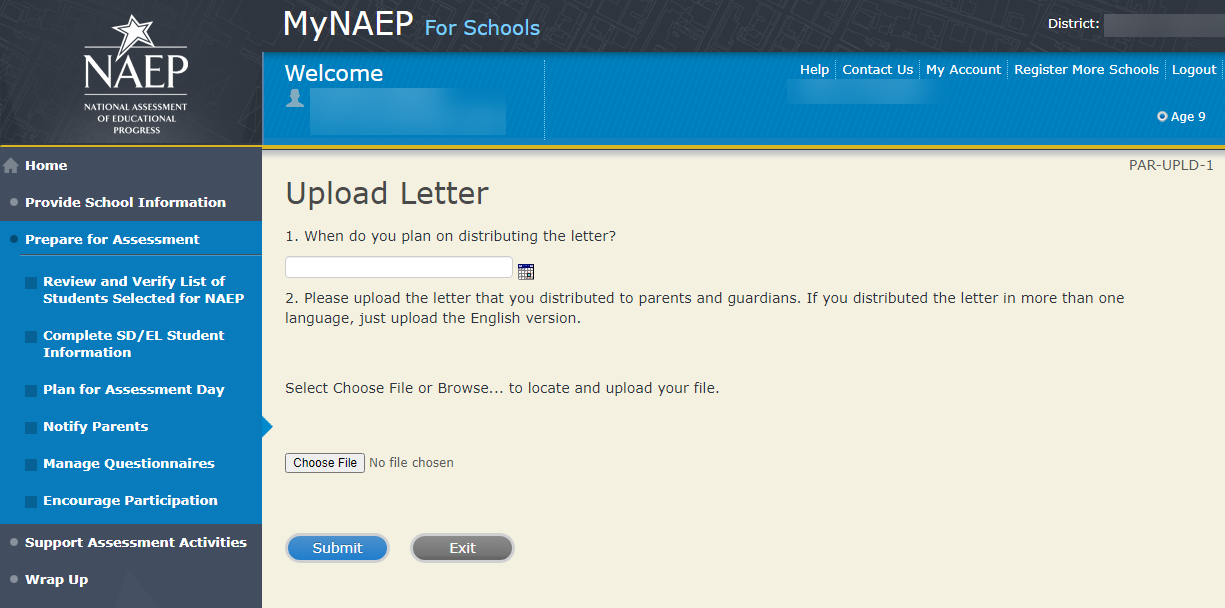
Verify Parent/Guardian Notification
Verify Parent/Guardian Notification-PAR-VER-1
Please tell us a few details about how you notified parents of the assessment.
1. When did you notify parents?
2. How did you notify them?
Mailed/emailed letter to parents
Sent letter home with students
Posted notice in newsletter
Other
*If you answered Other to the above question, please explain.
3. Other than updating the placeholder text, did you make any changes to the letter?
Yes No
4. Who received a notification?
Parents/guardians of sampled students only
Parents/guardians of all age X students
5. Please certify that you notified parents and guardians of the assessment by typing your name in the box.
Summary of Changes from OMB #1850-0928 v. 25:
Change Age 9 to Age 13
Screenshot

Manage Questionnaires
Note: In this section the school coordinator identifies the respondent for the school questionnaire, sends respondent link to online questionnaire, and monitors completion of questionnaire. Additionally, the school coordinator distributes information about NAEP to teachers (see Appendix D4-6). The results of the questionnaire are used to provide contextual data from schools and teachers in The Nation’s Report Card.
Prepare for Assessment
Manage Questionnaires
NAEP collects information using a school questionnaire to provide a context for reporting student performance. This questionnaire is usually completed by the principal, and it gathers information on school policies and characteristics.
This section also allows you to monitor the completion of the questionnaire and to send reminders. Please note that your questionnaire recipient will receive automatic reminder emails to complete the questionnaire weekly, so you will likely not need to send any reminders yourself.
Complete the following:
Watch Manage Questionnaires Tutorial (4:03) (https://bcove.video/2xiQOiX)
Identify Questionnaire Respondents
Send Welcome Emails and Questionnaires
Monitor Questionnaire Completion and Send Reminder Emails
Additional Resources
Facts for Teachers (see Appendix D4-6)
NAEP Survey Questionnaires for Teachers and Schools
Summary of Changes from OMB #1850-0928 v. 25:
Change Age 9 to Age 13
Screenshot
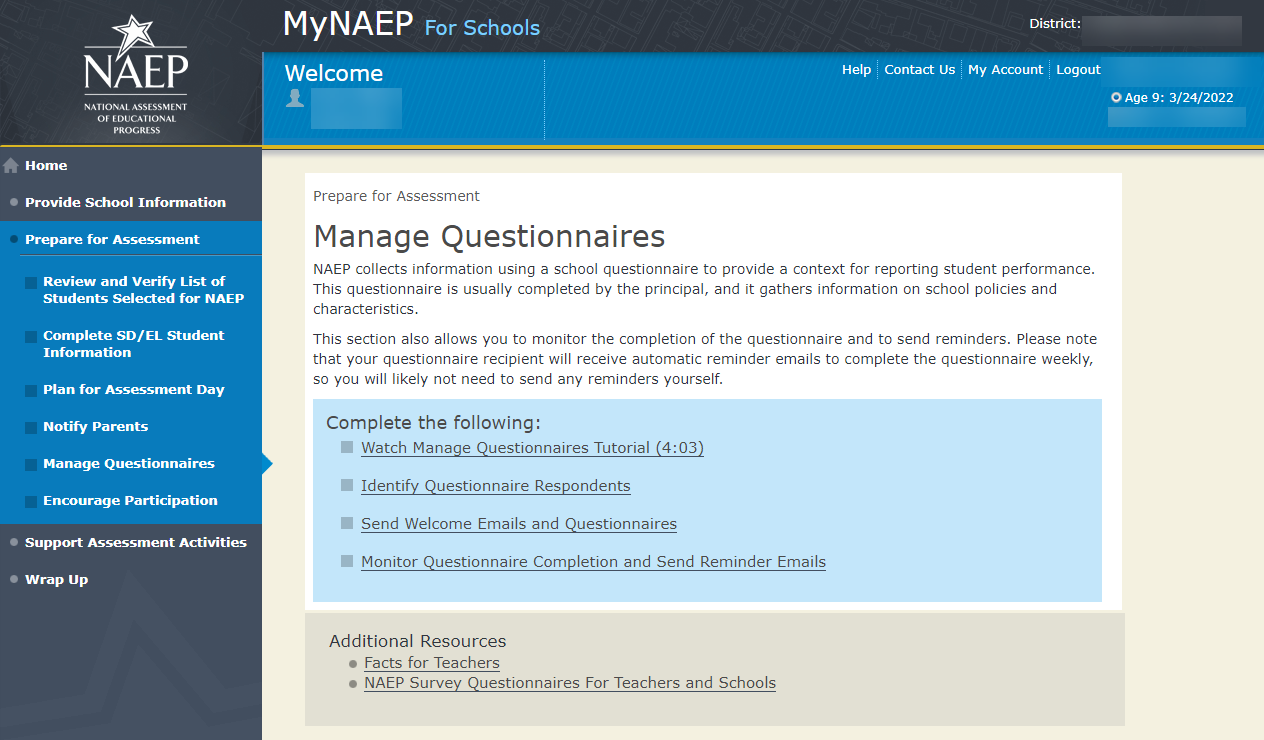
Identify Questionnaire Respondents
QX-RES-2
Identify Questionnaire Respondents
The School Questionnaire is used to gather information concerning school administration, staffing patterns, curriculum, and student services. It should be completed by the principal or another school official.
Make any necessary updates to the contact information of the School Questionnaire recipient by selecting the Edit Pencil. Make any updates in the pop-up box and select Save. When finished with all updates, select Submit.
Edit
First Name
Last Name
Email
No first name, last name or email address has been specified. Please select the edit pencil and enter contact information for the school questionnaire.
Summary of Changes from OMB #1850-0928 v. 25:
Change Age 9 to Age 13
Screenshot

Send Welcome Emails and Questionnaires
QX-WEL-1
Send Welcome Emails and Questionnaires
Send Welcome Emails
Now it's time to make sure that NAEP has the correct email addresses of your recipients. Select the Send buttons in the table below to send each person a welcome email.
First Name
Last Name
Questionnaire Type
Send Welcome Email
Send Date
Email Status
Not sure if everyone received the welcome email?
Check to ensure each recipient received the email.
Double-check the email address. If the address is correct and the recipient still did not receive the email, the recipient should check his or her junk email folder.
To add, edit, or delete recipients, return to the Identify Respondents page.
Summary of Changes from OMB #1850-0928 v. 25:
Change Age 9 to Age 13
Screenshot
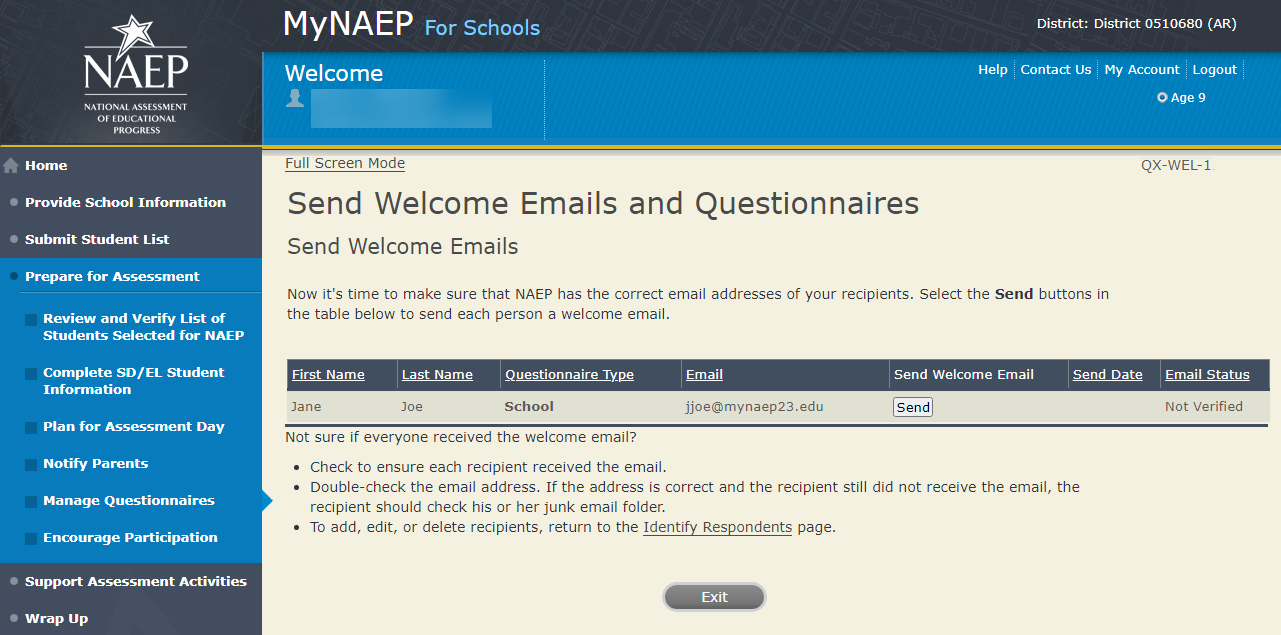
Monitor Questionnaire Completion and Send Reminder Emails
QX-MON-1
Monitor Questionnaire Completion and Send Reminder Emails
Monitor questionnaire completion using the Status column. Please ensure that all questionnaires have a status of "Completed" before your assessment day.
Select Send to send teachers and administrators email reminders.
Edit
Delete
Teacher #
First Name
Last Name
Questionnaire Type
Date Questionnaire Sent
Send Reminder
Status
Hard Copy
Refusal/Ineligible
*The green check mark will only appear if the questionnaire status is Complete, Hard Copy, Refused, or No longer at school.
Summary of Changes from OMB #1850-0928 v. 25:
Change Age 9 to Age 13
Screenshot
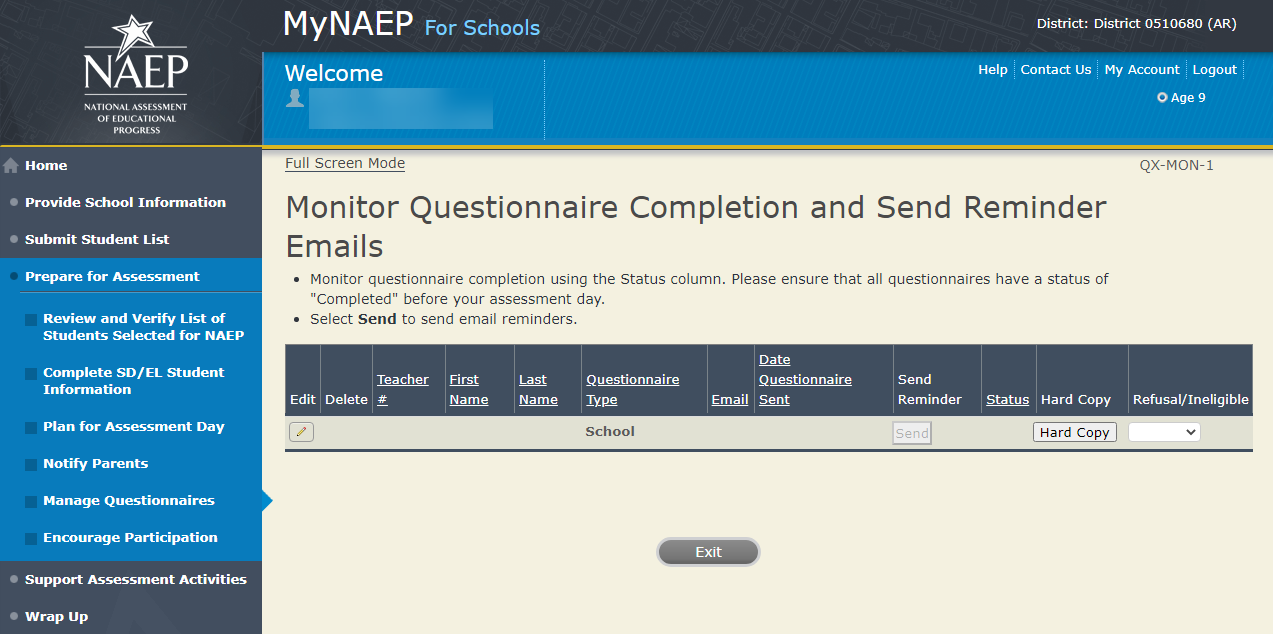
Encourage Participation
Note: In this section the school coordinator can access resources to encourage participation among students to ensure that the administration is successful.
Prepare for Assessment
Encourage Participation
NAEP is successful because of your support, and we want NAEP to be a positive experience for everyone involved at your school. The more that teachers, parents, and students know about NAEP, the more smoothly assessment day will go.
If less than 90% of the selected students attend the assessment, the NAEP team may need to return to your school for a makeup assessment at a later date. Use the resources in this section to encourage students to attend and to do their best on NAEP.
Complete the following:
Watch Encourage Participation Tutorial (2:06) (https://bcove.video/2xyGZwU)
Review Resources
Select Strategies to Encourage Participation
Summary of Changes from OMB #1850-0928 v. 25:
Change Age 9 to Age 13
Screenshot

Review Resources
ENC-RES-1
Explore the resources below to promote NAEP in your school. Schools that implement these strategies have higher student participation.
Notify Students
Show NAEP Videos
Introduce Online Resources
Thank Students for their Participation
When you are finished, select the Submit button.
Summary of Changes from OMB #1850-0928 v. 25:
Change Age 9 to Age 13
Screenshot
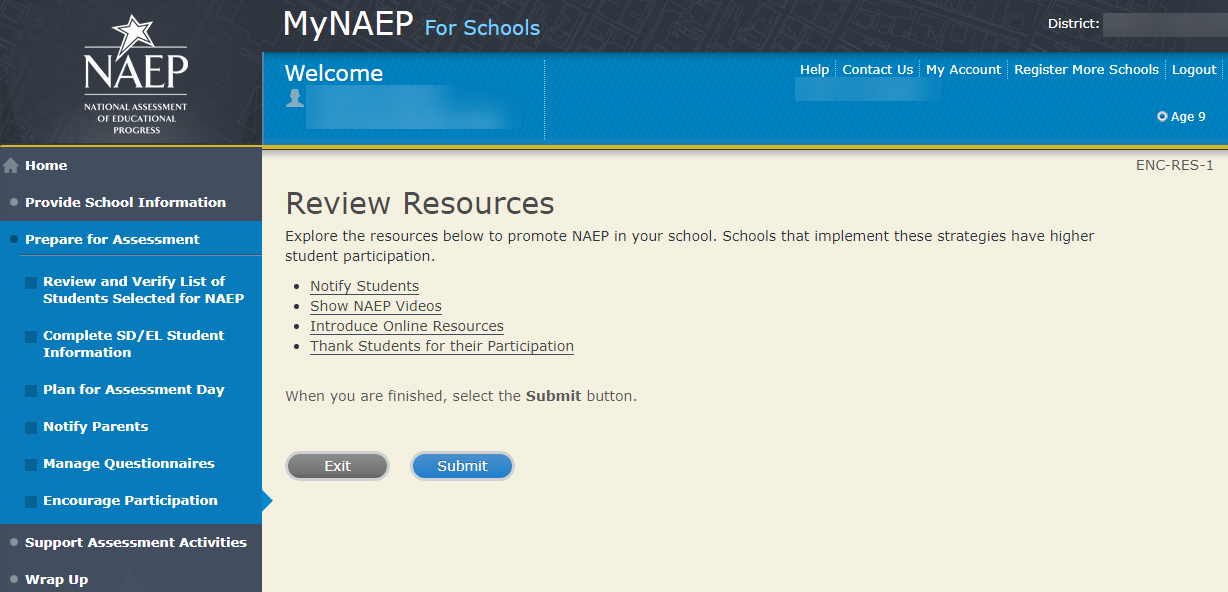
Encourage Participation
Notify Students about NAEP-ENC-STDT-1
It’s important for students to know the importance of NAEP and that they have been selected to represent their peers across the country. Use the templates below to share information about NAEP, its importance, and details about the upcoming assessment.
Sample Morning Announcements - Age 13- (65 KB, DOCX)
Social Media Posts - Age 13- (79 KB, DOCX)
Summary of Changes from OMB #1850-0928 v. 25:
Change Age 9 to Age 13
Screenshot

Encourage Participation
Videos-ENC-VID-1
See what real students and teachers have to say about NAEP. These videos share information about how NAEP results are used, and how students and teachers can make a difference through their participation.
Introducing NAEP to Teachers (4:27) (https://youtu.be/zR1_pUdSlFg)
Introducing NAEP to Students (4:36) (https://youtu.be/8drjkhe0iQU)
What Every Parent Should Know About NAEP (4:51) (https://youtu.be/RurH739zdN0)
Summary of Changes from OMB #1850-0928 v. 25:
Change Age 9 to Age 13
Screenshot

Encourage Participation
NAEP Online-ENC-INOR-1
The Nation's Report Card website has resources for all audiences. (https://nces.ed.gov/nationsreportcard/)
Nation’s Report Card: Student’s page (https://nces.ed.gov/nationsreportcard/students/)
Students selected for NAEP can test themselves and answer real assessment questions (https://nces.ed.gov/nationsreportcard/nqt/) for different subject areas.
Nation’s Report Card: Educator's page (https://nces.ed.gov/nationsreportcard/educators/)
Teachers can create their own tests (https://nces.ed.gov/nationsreportcard/nqt/) using NAEP assessment items, and can also explore NAEP results.
Nation’s Report Card: Parent’s page (https://nces.ed.gov/nationsreportcard/parents/)
Parents can review what participation in NAEP means for their child (https://nces.ed.gov/nationsreportcard/parents/#sec2) and how results from assessments are used.
Summary of Changes from OMB #1850-0928 v. 25:
Change Age 9 to Age 13
Screenshot

Thank Students for Their Participation
Schools have been very creative in the variety of incentives used to encourage students to “show up” for the NAEP assessment. Many of their strategies did not cost the school anything. Examples of incentives that schools implemented include:
extra credit;
reduced-price or free school event tickets;
raffle of gift certificates; and
Work with your principal to consider ways to thank students for their participation.
Summary of Changes from OMB #1850-0928 v. 25:
Change Age 9 to Age 13
Screenshot
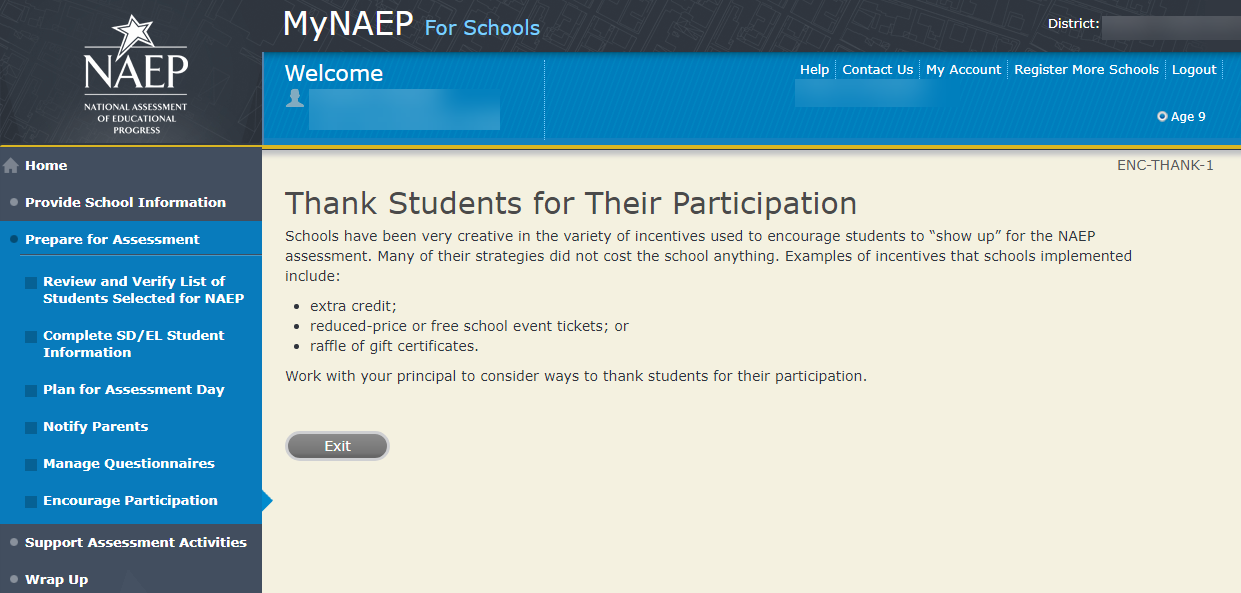
Encourage Participation
Select Strategies to Encourage Participation
ENC-STRAT-1
Strategies
Which strategies below have you used or do you plan on using at your school? This information helps us develop more effective resources for you.
Notify students
Show NAEP videos
Introduce NAEP online resources
Thank students for their participation
Other, specify
None
Summary of Changes from OMB #1850-0928 v. 25:
Change Age 9 to Age 13
Screenshot

Support Assessment Activities
Support Assessment Activities
Help students remember the date, time, and location of the assessment. Use the link below to print Student Appointment Cards and distribute them to the students.
Circulate the Teacher Notification Letter. Attach the Listing of Sampled Students to the letter so that teachers can direct students to the correct assessment location. This list is private and should be returned to you after the assessment.
Complete the following:
Print Student Appointment Cards (see Additional Resources section of this document)
Print Teacher Notification Letter for distribution to teachers (see Additional Resources section of this document)
Print Listing of Sampled Students
Additional Resources
Facts for Teachers (see Appendix D4-6)
Summary of Changes from OMB #1850-0928 v. 25:
Change Age 9 to Age 13
Screenshot

Wrap Up
Wrap Up
The final task remaining for you is to securely store and eventually dispose of all NAEP materials. Please safeguard all materials until the end of the school year. You will receive an email reminder at that time to destroy the materials in a secure manner.
Summary of changes from OMB #1850-0928 v. 25
Change Age 9 to Age 13
Screenshot
 Note:
The following content is the text that displays after clicking on the
hyperlinks listed in the preceding pages of this document
Note:
The following content is the text that displays after clicking on the
hyperlinks listed in the preceding pages of this document
Additional Resources
Prepare for Assessment
Instructions for the School Coordinator brochure
Instructions for the School Coordinator Long-Term Trend
Completing Preassessment Activities for NAEP 2022
Thank you for your support of the National Assessment of Educational Progress (NAEP) for 2022. We look forward to working with you to make NAEP a positive experience at your school. This begins with completing activities before the assessment.
For the upcoming assessments, the MyNAEP for Schools website will serve as your primary resource to prepare for the assessment. MyNAEP provides you with an electronic way to complete the preassessment tasks at your own pace. Visit the MyNAEP website at www.mynaep.com to get started. If you have not yet registered for MyNAEP, refer to the School Coordinator Responsibilities: A Guide to MyNAEP brochure you received earlier this fall for instructions, or your NAEP representative can assist you.
Your NAEP representative will follow up with you very soon to review the activities listed in this brochure and answer any questions you may have about completing these tasks. There are short video tutorials for each task, and we recommend reviewing them before completing the tasks.
If you need assistance before then, contact the NAEP help desk at
1-800-283-NAEP (6237) or by email at NAEPHelp@westat.com.
Thank you for your support of the National Assessment of Educational Progress!
August 2022
In August 2022 the sections of Prepare for Assessment on MyNAEP will be available to schools. At that time you can begin to complete the preassessment tasks listed below by selecting the Prepare for Assessment link.
Review and Verify List of Students Selected for NAEP
In this section, you will review the list of students selected for NAEP for accuracy and completeness. This section must be completed before completing the SD/EL student information.
Update missing or incorrect student demographic data.
Update missing or incorrect classifications for students with disabilities (SD), student with 504 plans, and English learners (EL).
Identify any students who cannot take NAEP.
Indicate if there are students who have been displaced from their regular school by an event such as a fire or hurricane.
Identify how students are attending classes such as full time in-person, hybrid (part-time) or full time virtual learner.
Complete SD/EL Student Information
In this section, you will review the list of students identified as SD and/or EL and provide information on what accommodations (if any) students require for NAEP.
Review NAEP inclusion policy.
Indicate how each student identified as SD and/or EL should be assessed on NAEP.
Plan for Assessment Day
In this section, you will provide information to help the NAEP team plan for assessments at your school.
Review the student group assignments for testing and provide the start time(s) and testing location(s).
Answer questions necessary to plan the assessment logistics.
Answer questions about COVID policies to safely administer the assessment.
Notify Parents/Guardians
By law, the parents/guardians of the students selected for NAEP must be notified in writing before the assessments can take place. In this section, you are given instructions for notifying parents/guardians about the assessment and will confirm that parents/guardians of the students selected for NAEP have been notified.
Notify parents/guardians as soon as possible using the Parent/Guardian Notification Letter (see Appendices D3-7, D3-8, D3-20, and D3-21) available to download in this section (available in both English and Spanish).
Verify parent/guardian notification.
Upload your Parent/Guardian Notification Letter and indicate when you plan to send the letter.
Manage Questionnaires
In this section, you will identify a school staff member to complete an online NAEP questionnaire and ensure the questionnaire is completed by the assessment date.
Confirm who will complete the School Questionnaire.
Send the welcome email and questionnaire link to the questionnaire recipient.
Encourage Participation
In this section, you will review strategies that can help motivate students to participate on NAEP. There are links to videos and other promotional materials.
Record what strategies you plan to use in your school.
Note that makeup sessions may be needed if the assessment is canceled due to weather or if attendance at the assessment is less than 90 percent.
1 week before assessment
Approximately 1 week before your assessment, visit the Support Assessment Activities section.
Support Assessment Activities
In this section, you have access to material for notifying students and faculty about the NAEP assessment.
Print Student Appointment Cards to distribute to students to notify them of the date, time, and location of the assessment.
Print the Teacher Notification Letter and distribute to all teachers. This letter provides the date, time, and location for each assessment session.
Print the List of Students Selected for NAEP and the Measure Up newsletter and distribute them, along with the Teacher Notification Letter, to all teachers for the selected age group.
Thank you for helping us make NAEP in your school a success!
Remember to visit the MyNAEP for Schools website at www.mynaep.com to receive details about the assessment activities in your school.
What Is NAEP?
The National Assessment of Educational Progress (NAEP) is the largest continuing and nationally representative assessment of what our nation’s students know and can do in core subjects. NAEP is congressionally mandated, and was first administered in 1969 to measure student achievement nationally. Teachers, principals, parents, policymakers, and researchers all use NAEP results to assess progress and develop ways to improve education in the United States.
For more information, visit http://nces.ed.gov/nationsreportcard or contact the NAEP help desk at 1-800-283-NAEP (6237) or by email at NAEPHelp@westat.com.
Brochure layout
Summary of changes from OMB #1850-0928 v. 25
Change Dates


Review and Verify List of Students Selected for NAEP
Information Needed to Review and Verify List of Students Selected for NAEP
Information Needed to Review and Verify List of Students Selected for NAEP
You will review and confirm the following information for each selected student.
State Unique Student ID (optional, can be left blank)
Month of Birth
Year of Birth
Gender
Race/ethnicity
National School Lunch Program eligibility status – only required if column appears (reduced price lunch, free lunch, student not eligible)
Student with disability classification (IEP, 504 and requires accommodations)
English Learner (Limited English Proficiency) status
Reason student cannot take NAEP (are any students withdrawn from school or ineligible for NAEP)
Remote/virtual learning program participation: Hybrid (Part-time) or Full-time virtual learner
Determine if any selected students cannot take NAEP
Please use the reasons in the bulleted list below to determine if any selected students cannot take NAEP.
Withdrawn
Graduated
Expelled
Attends all classes on a different campus
Traditional homeschool learner - parent provides curriculum and may/may not act as instructor
Student listed more than once
Foreign exchange student
Student deceased
Long-term illness/homebound (will not be in school during NAEP testing).
Parent notified about NAEP and refused NAEP testing.
Student notified about NAEP and refused NAEP testing.
Student meets (or met) participation criteria for the state alternate assessment (student is currently eligible or was eligible in the past to take the state alternate assessment).
Student is classified as an English learner and has been enrolled in U.S. schools less than 1 full academic year before the NAEP assessment and cannot access NAEP.
Full-time virtual learner (does not attend school in-person)
Review and verify student demographic information
NAEP collects demographic information to report results for student groups. Please provide any missing information, and review for accuracy.
Race/Ethnicity:
Hispanic, of any race: A person of Mexican, Puerto Rican, Cuban, Central or South American, or other Spanish (but not Portuguese) culture of origin, regardless of race.
White, not Hispanic: A person having origins in any of the original peoples of Europe (except Spain), North Africa, or the Middle East.
Black or African American, not Hispanic: A person having origins in any of the Black peoples of Africa.
Asian, not Hispanic: A person having origins in any of the original peoples of the Far East, Southeast Asia, the Indian Subcontinent, including, for example, Cambodia, China, Japan, India, Korea, Malaysia, Pakistan, the Philippine Islands, Thailand, and Vietnam.
American Indian or Alaska Native, not Hispanic: A person having origins in any of the original peoples of North and South America (including Central America), and who maintains tribal affiliation or community attachment.
Native Hawaiian or Pacific Islander, not Hispanic: A person having origins in any of the original people of Hawaii, Guam, Samoa, or other Pacific Islands.
Two or More Races (Non-Hispanic): A person who identifies with two or more of the non-Hispanic categories above.
School Lunch Status – if column appears:
Student not eligible to participate: Student is not eligible for free or reduced-price lunch.
Free lunch: Student is eligible for free lunch. Schools participating in Provisions 2 or 3 of the National School Lunch Program (NSLP) should code all students as “free lunch.”
If it is not possible to distinguish between “free” and “reduced price” for some students, code these students as eligible for free lunch.
Reduced price lunch: Student is eligible for reduced-price lunch.
School not participating: School does not participate in the NSLP. When used, this code must be applied to all students.
Review and verify classifications of Students with Disabilities (SD) and English Learners (EL)
Please indicate each student’s SD/EL classification with these codes.
Students with disabilities (SD):
Yes, IEP: Student has a formal Individualized Education Plan (IEP) or the student’s IEP is in progress.
Yes, 504: Student has a 504 plan and needs accommodations to participate in NAEP. If the student does not need accommodations to be tested on NAEP, classify the student as No, not SD.
No, not SD: Student does not have an IEP
English learners (EL):
Yes, EL: A student who has not achieved full English proficiency, and is in the process of acquiring English language skills and knowledge. Some schools refer to these students as limited English proficient (LEP).
No, Formerly EL: A student who has achieved full English proficiency, is monitored, and is included in EL subgroup for accountability reporting for 2 years (or 4 years depending on state policy) after exiting.
No, not EL: Student is not an English learner.
Dept. of Agriculture Memo Authorizing Release of NSLP to NAEP
This memo replaces the United States Department of Agriculture (USDA) Letter
Date: School Year 2022–23
To: School Nutrition Program Personnel
From: National Assessment of Educational Progress (NAEP)
Subject: Policy on Limited Disclosure of Children's Eligibility Information to NAEP
As stated in the Eligibility Manual for School Meals (Section 5 - Confidentiality and Disclosure, Disclosure Requirements), school food authorities may disclose, without parent/guardian consent, children’s names and eligibility status (whether they are eligible for free meals or free milk or reduced price meals) to persons directly connected with the administration or enforcement of a Federal or State education program, such as NAEP, as permitted by section 9(b)(6)(A)(ii)(I) of the Richard B. Russell National School Lunch Act.
The relevant section from page 88 of the Eligibility Manual for School Meals is shown below:
Because NAEP is a Federal education program, LEAs may disclose, without parent or guardian consent, children’s names and eligibility status to persons directly connected to the administration or enforcement of NAEP. Additionally, LEAs may disclose children’s names and eligibility status to persons directly connected with the administration or enforcement of State educational assessment programs to the extent the State assessment is part of the NAEP. Other State education programs may access participants' names and eligibility status, without parent or guardian consent. However, in both situations, the program must be established at the State (not local) level.
The term “persons directly connected” for the purpose of disclosure to NAEP includes Federal, State, and local program operators responsible for NAEP administration or compliance, and their contractors. This does not imply that these persons have routine access to participants' eligibility status. There must be a "need to know" relating to the administration or enforcement of a Federal education program or for legitimate NAEP purposes.
The above information is available on the FNS website at https://www.fns.usda.gov/eligibility-manual-school-meals and then select, “Eligibility Manual.”
Complete SD/EL Student Information
Inclusion on NAEP Fact Sheet
Inclusion on NAEP
Students with Disabilities and English learners
WHAT IS NAEP?
The National Assessment of Educational Progress (NAEP) is the largest continuing and nationally representative assessment of what our nation’s students know and can do in core subjects such as mathematics and reading.
NAEP is congressionally mandated, and was first administered in 1969 to measure student achievement nationally. Teachers, principals, parents, policymakers, and researchers all use NAEP results to assess progress and develop ways to improve education in the United States.
The Importance of Inclusion
The responses of students with disabilities and English learners on NAEP represent those of hundreds of other similar students. Without them, information about how to best meet the educational needs of these students would be lost. NAEP incorporates inclusive policies and practices into every aspect of the assessment, including selection of students, participation in the assessment administration, and valid and effective accommodations. Such best practices are essential to ensuring an inclusive assessment that yields meaningful NAEP results for all students with disabilities and English learners. By representing their peers across the nation on NAEP, students with disabilities and English learners help to ensure that NAEP results can be used to inform efforts to improve educational programs.
To ensure that the National Assessment of Educational Progress (NAEP) reflects the educational progress of all students, students with disabilities and English learners must be included to the fullest extent possible.
Selection
Students with disabilities and English learners are selected to participate in NAEP just like any other student. NAEP is administered to a sample of students who represent the student population of the nation as a whole and of individual states and districts participating in the Trial Urban District Assessment (TUDA). Within each selected school and grade to be assessed, students are chosen at random to participate in NAEP. Regardless of race/ethnicity, socioeconomic status, disability, status as an English learner, or any other factors, every student has the same chance of being chosen.
For more information about NAEP, visit http://nces.ed.gov/nationsreportcard
For More Information Contact your NAEP State Coordinator with specific questions about including students with disabilities and English learners. Details of the National Assessment Governing Board’s policy on testing and reporting results on students with disabilities and English learners on NAEP are available at https://www.nagb.gov/content/dam/nagb/en/documents/publications/inclusion-special-population-naep.pdf. http://www.nagb.org/ publications/inclusion- special-population-naep.pdf. Current NAEP accommodations and inclusion policies are posted on the website at http://nces.ed.gov/nationsreportcard/about/inclusion.asp.
Participation
Many students with disabilities and English learners are able to participate in the assessment administration alongside their peers.
Participating in NAEP allows students with disabilities and English learners to experience a large-scale assessment administration without high-stakes consequences. Since NAEP does not produce scores for individual students or results for schools, participation in NAEP is not tied to grades or evaluations of students, teachers, or schools.
Accommodations
Students with disabilities and English learners are provided with testing accommodations so that they can demonstrate their content knowledge and skills on NAEP. NAEP offers a comprehensive set of accommodations to increase access to testing for students with disabilities and English learners. To ensure that appropriate accommodations are determined for individual students, NAEP relies on school staff to make inclusion and accommodations decisions for those students selected for the assessment.
The accommodations allowed on NAEP and those allowed in states are often similar, but there may be some differences. Sometimes these differences result from the way that the subject being measured is defined in the NAEP frameworks. For example, NAEP does not allow read-aloud of any part of the NAEP reading test except the instructions, because decoding words is part of what the NAEP framework is measuring.
Your NAEP State Coordinator has developed inclusion guidelines for including students with disabilities and English learners on NAEP and provided them to schools selected for the assessment. These instructions will highlight any differences between NAEP and your state’s policies and provide guidance on how to include and accommodate sampled students.
Brochure layout
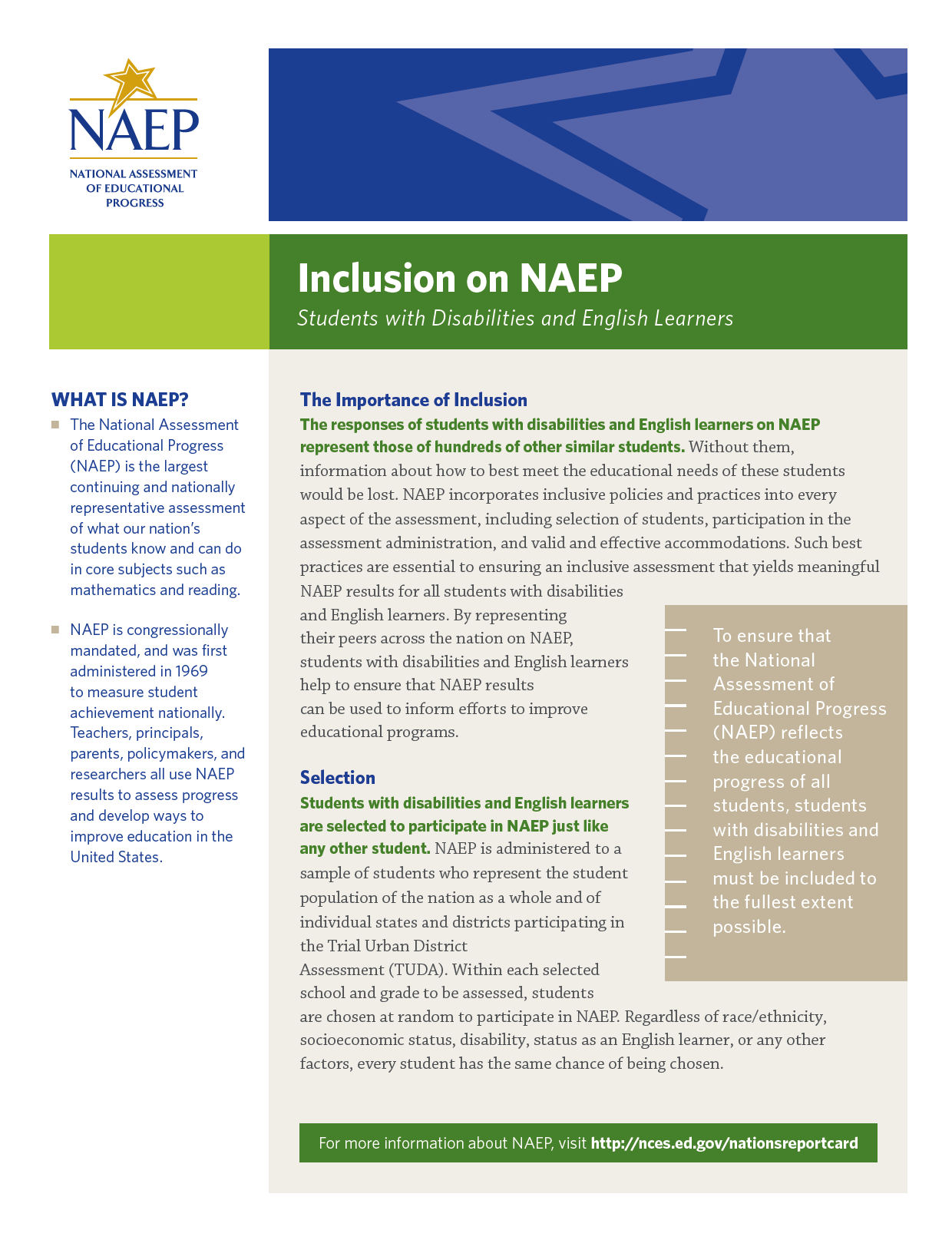
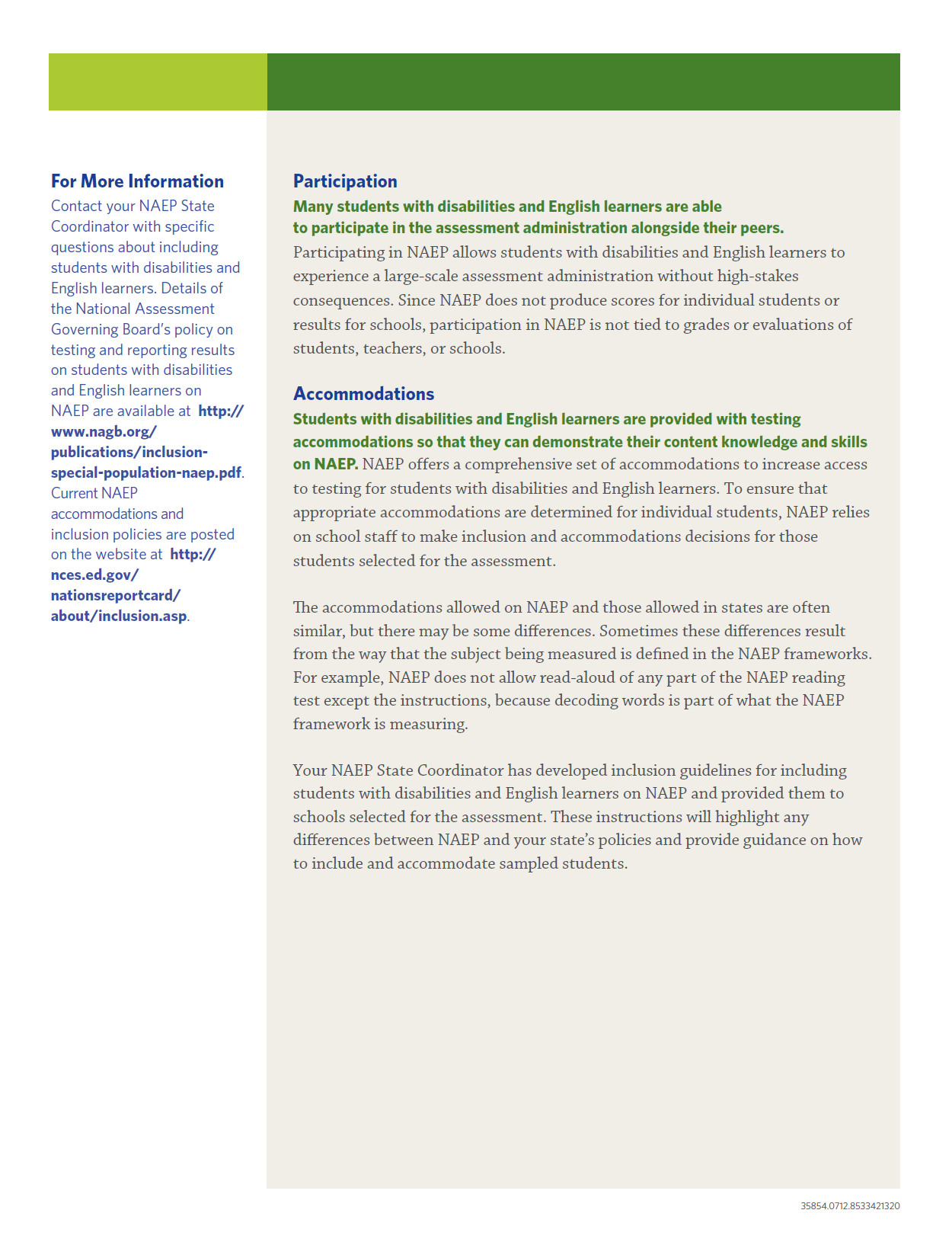
Letter from Department of Education Encouraging Inclusion
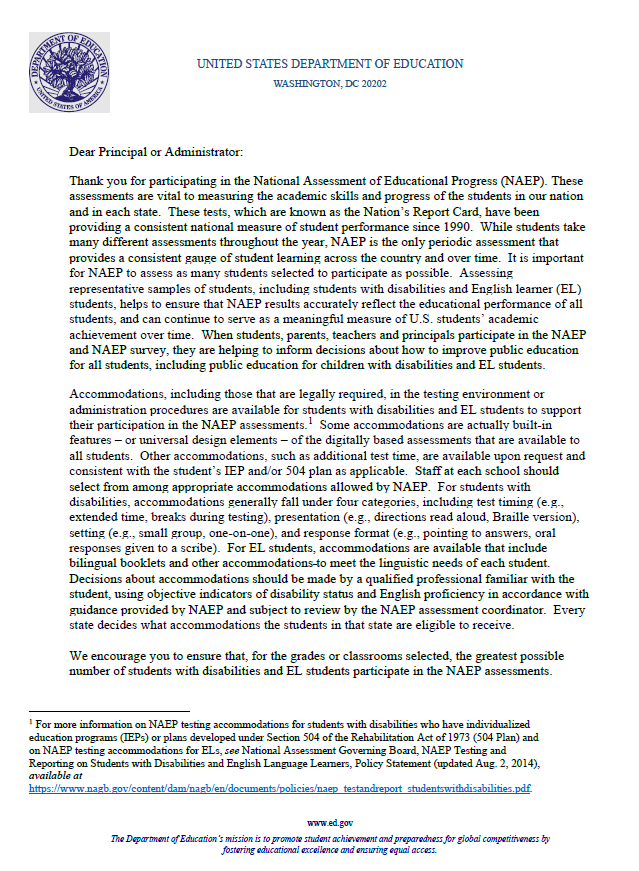
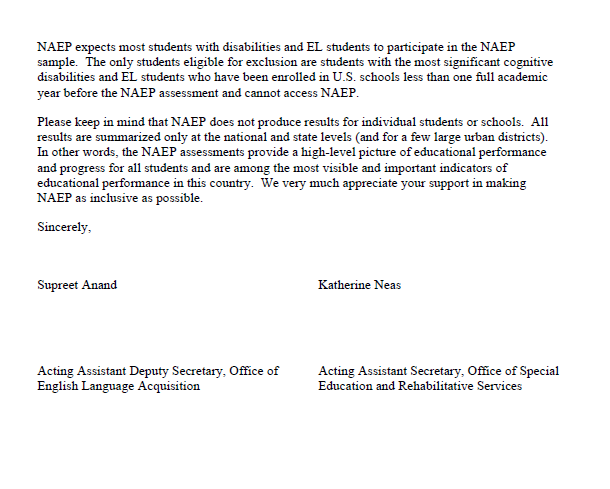
Information Needed to Include SD/EL Students
Information Needed to Include Students with Disabilities
You will enter the following information for each sampled student classified as a student with disability.
The IDEA category that best describes the student’s disability. The following categories are used by the Individual with Disabilities Education Act (IDEA).
Specific learning disability
Hearing impairment/deafness
Visual impairment/blindness
Speech or language impairment
Intellectual disability
Emotional disturbance
Orthopedic impairment
Traumatic brain injury
Autism
Development delay (age 9 or younger)
Other health impairment (specify)
The degree of each student's disability.
Mild
Moderate
Profound/Severe
Grade-level performance for the subject to be assessed.
At or above grade level
One year below grade level
Two or more years below grade level
Not receiving instruction in the designated subject (math or reading)
How is the student assessed on the state assessment? If your state does not offer a state assessment, use classroom assessments as a reference point.
With accommodations
Without accommodations
With an alternate assessment, etc.
Testing accommodations that each student typically receives.
Information Needed to Include English learners
You will enter the following information for each sampled student classified as an English Learner (Limited English Proficiency).
Each student’s primary language.
How long has each student received academic instruction in English?
Does not receive instruction primarily in English
Less than 1 year
1 to 2 years
2 to 3 years
3 years or more
Grade-level performance for the subject to be assessed.
At or above grade level
One year below grade level
Two or more years below grade level
Not receiving instruction in the designated subject (math or reading)
Each student’s English proficiency for listening, reading, speaking and writing.
No proficiency
Beginning
Intermediate
Advanced
How long has each student been enrolled in U.S. schools?
Less than 1 full academic year
1 full academic year or more
Testing accommodations that each student typically receives.
Notify Parents
Parent’s page on Nation’s Report Card website
This resource is a hyperlink to the NCES site: https://nces.ed.gov/nationsreportcard/parents/.

What Every Parent Should Know About NAEP: PDF version
This brochure is available here on the NCES website: http://nces.ed.gov/nationsreportcard/pdf/parents/2012469.pdf.
What Every Parent Should Know About NAEP: Video version
This video is available here on the NCES website: https://youtu.be/RurH739zdN0.
Sample Questions Booklets
This resource is a hyperlink to all the sample questions booklets posted on the NCES site: https://nces.ed.gov/nationsreportcard/about/booklets.aspx.
Manage Questionnaires
Manage Questionnaires Welcome Email
Dear [Respondent Name],
The National Assessment of Educational Progress (NAEP) is the only ongoing assessment of what our nation’s students know and can do in a variety of subjects. Age 13 students at [school name] will take [mathematics and reading] assessments on [assessment date].
In addition to conducting assessments, NAEP gathers information on school policies and characteristics by using a school questionnaire. [School coordinator name] has identified you as the respondent. Your responses will provide important information for educators, policymakers, and researchers to better understand the context in which students learn. This enhanced understanding can help improve education in our nation's classrooms.
Please select the link below or copy/paste into your browser to receive your questionnaire link and password in two additional emails.
[Verification link]
Visit https://nces.ed.gov/nationsreportcard/experience/survey_questionnaires.aspx to explore how your responses contribute to NAEP’s ability to report on what our nation’s students know and can do.
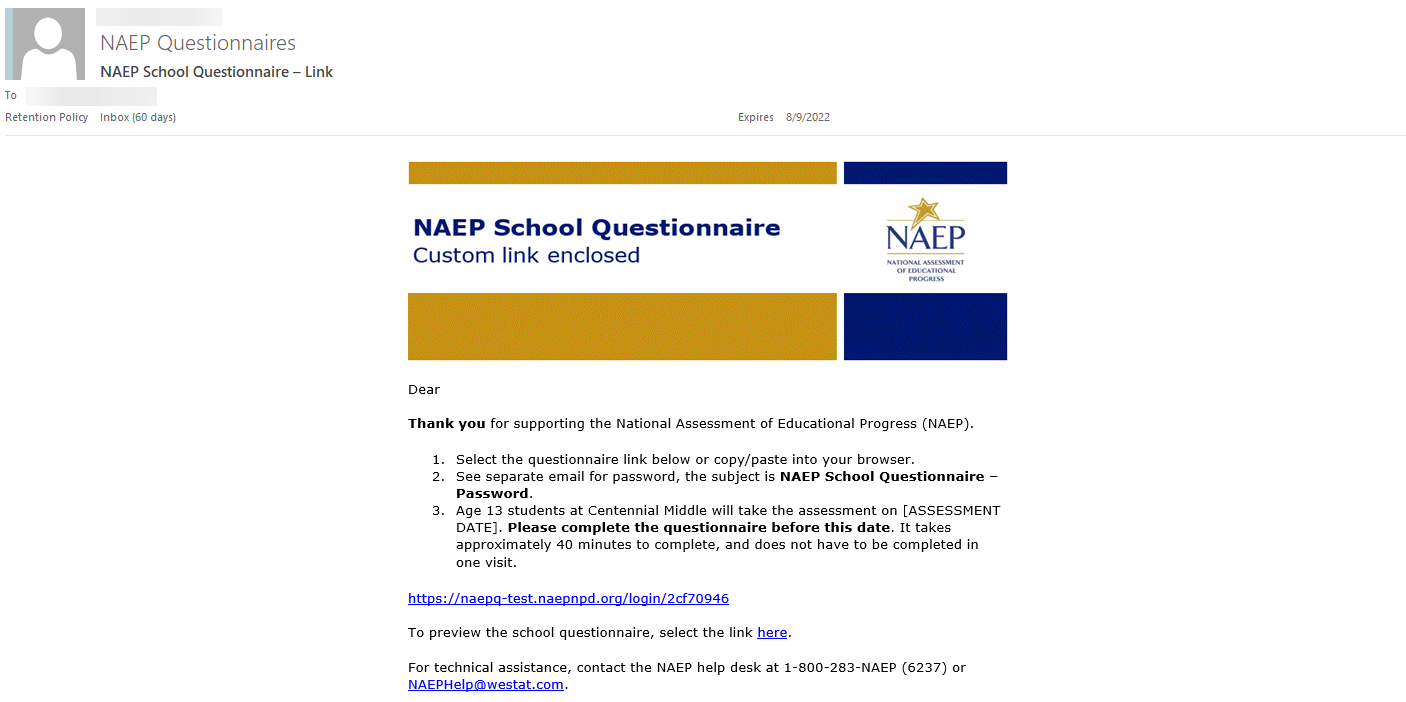 Manage
Questionnaires – NAEP School Questionnaire - Link
Manage
Questionnaires – NAEP School Questionnaire - Link
Manage Questionnaires – NAEP School
Questionnaire - Password
Manage Questionnaires Reminder Email

Manage Questionnaires Reminder Password
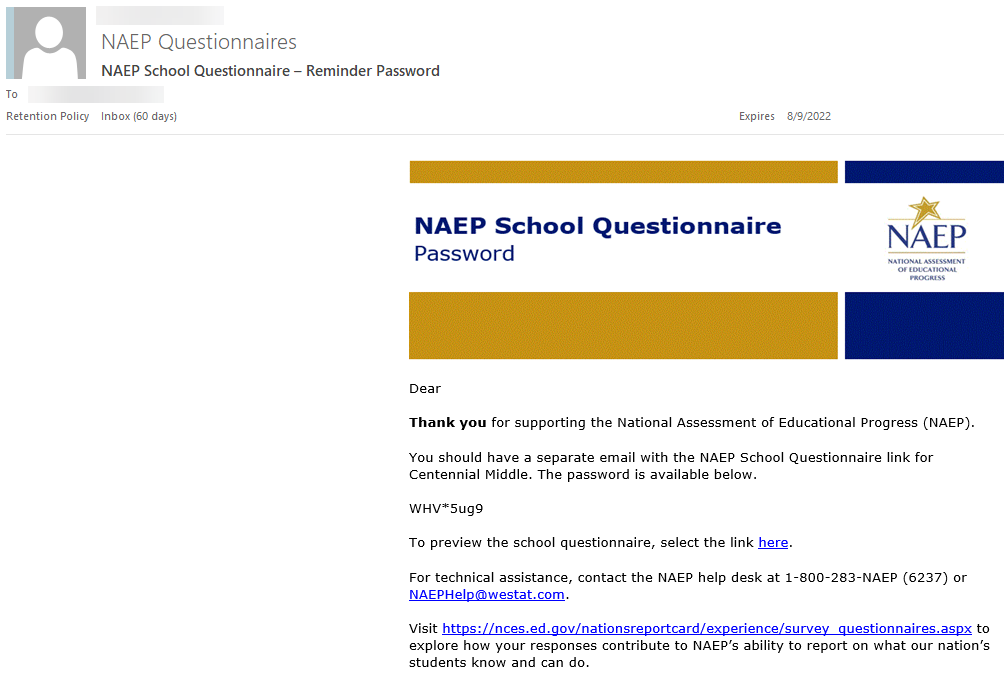
Support Assessment Activities
Teacher Notification Letter
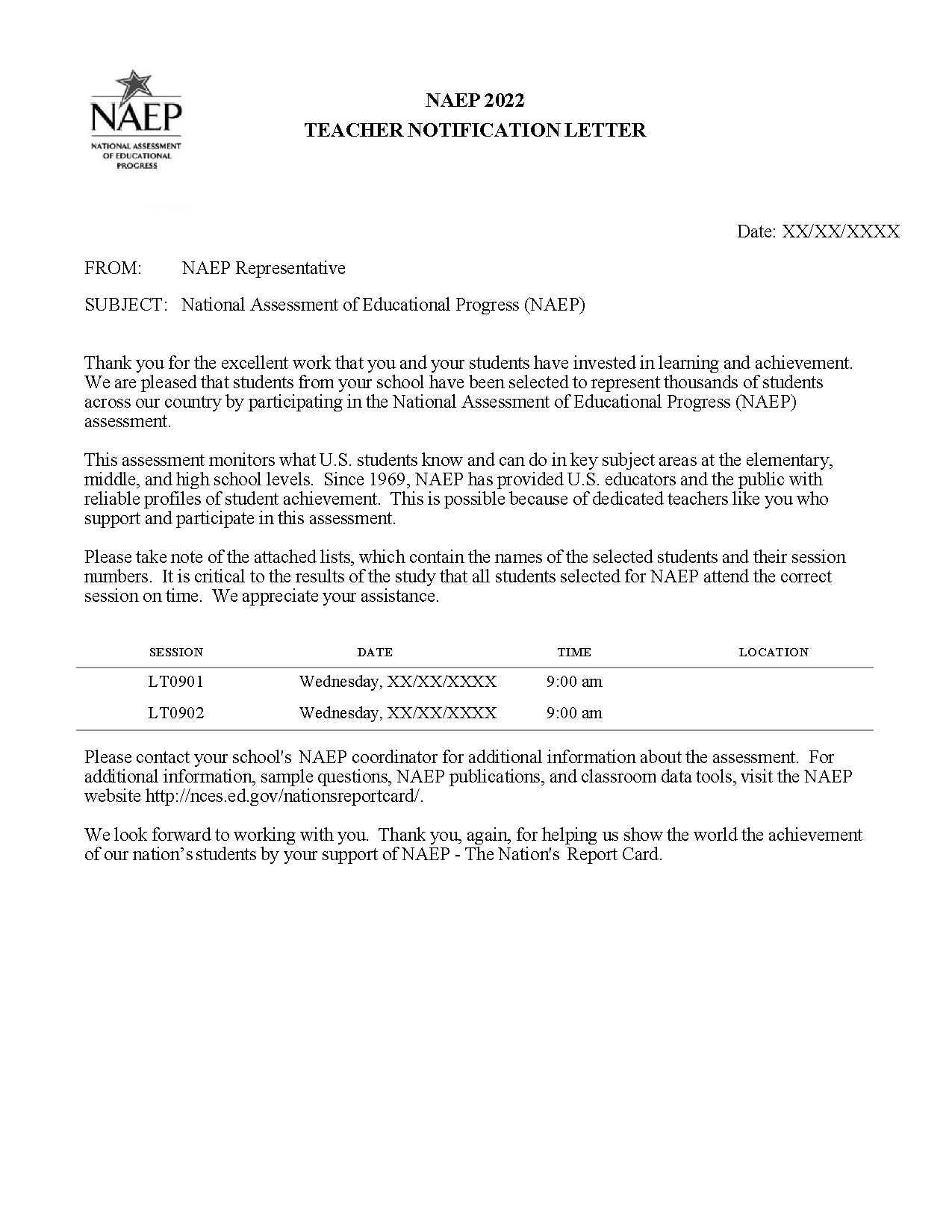
Appointment Cards

1 Please note that parents/legal guardians are required to receive notification of student participation but NAEP does not require explicit parental consent (by law, parents/guardians of students selected to participate in NAEP must be notified in writing of their child’s selection prior to the administration of the assessment).
| File Type | application/vnd.openxmlformats-officedocument.wordprocessingml.document |
| Author | Betsy Magrini |
| File Modified | 0000-00-00 |
| File Created | 2024-09-14 |
© 2026 OMB.report | Privacy Policy